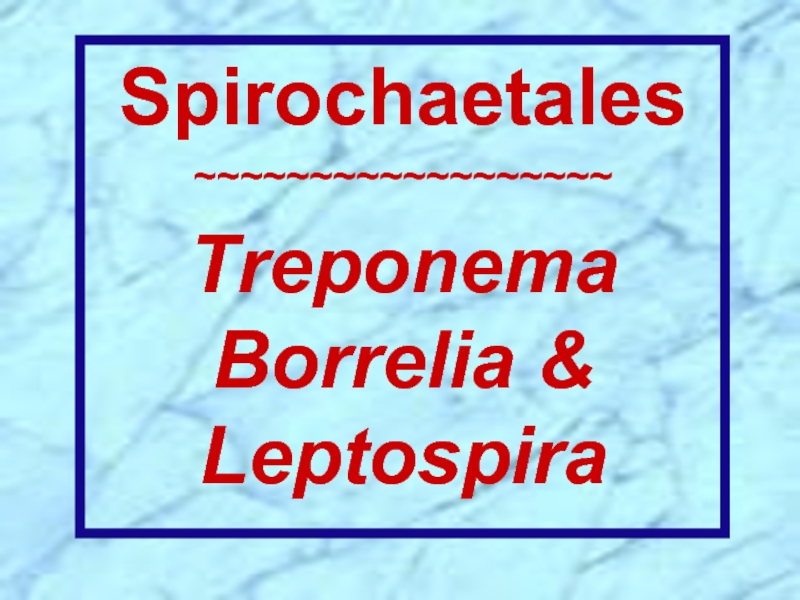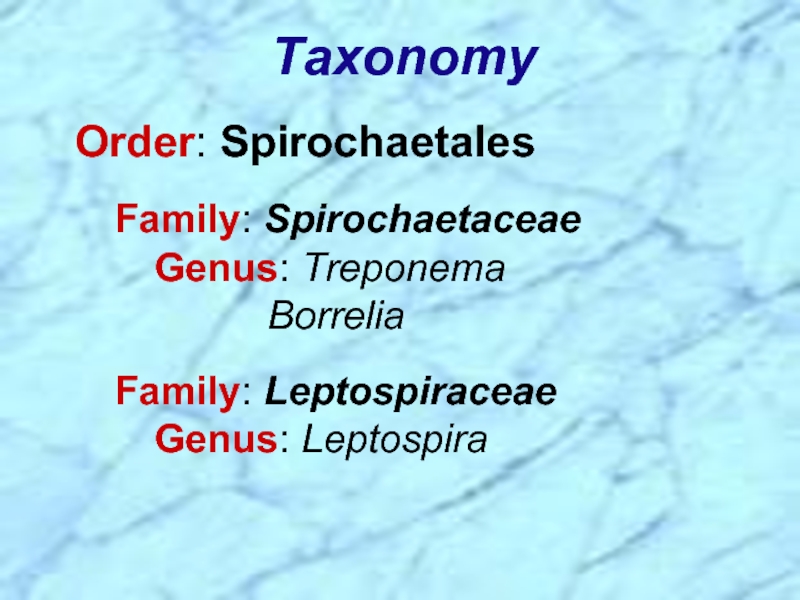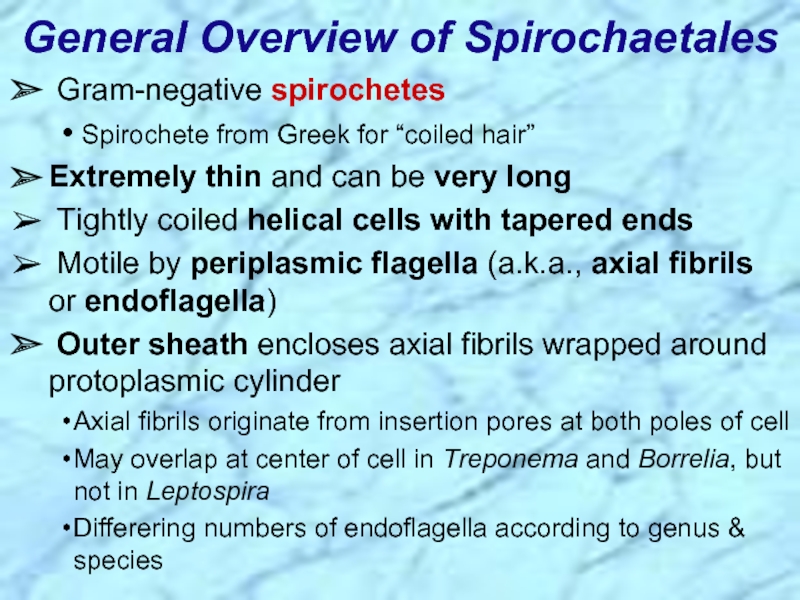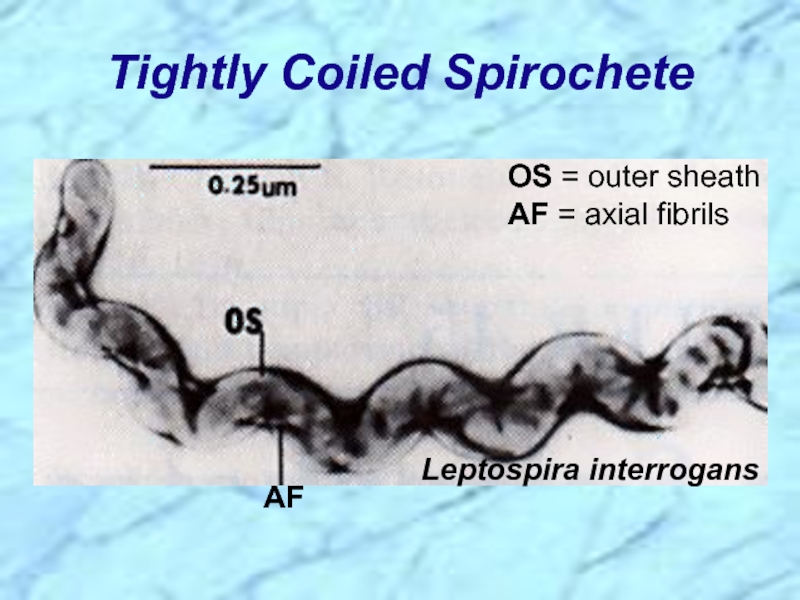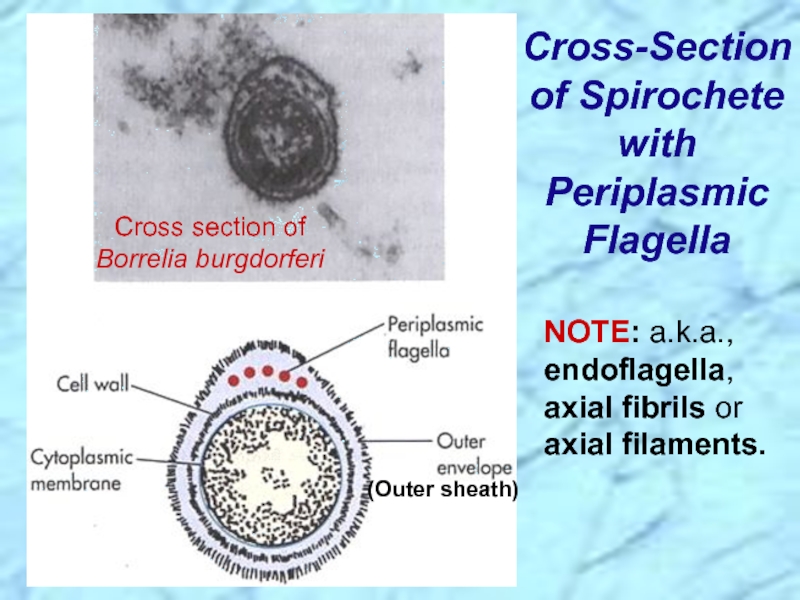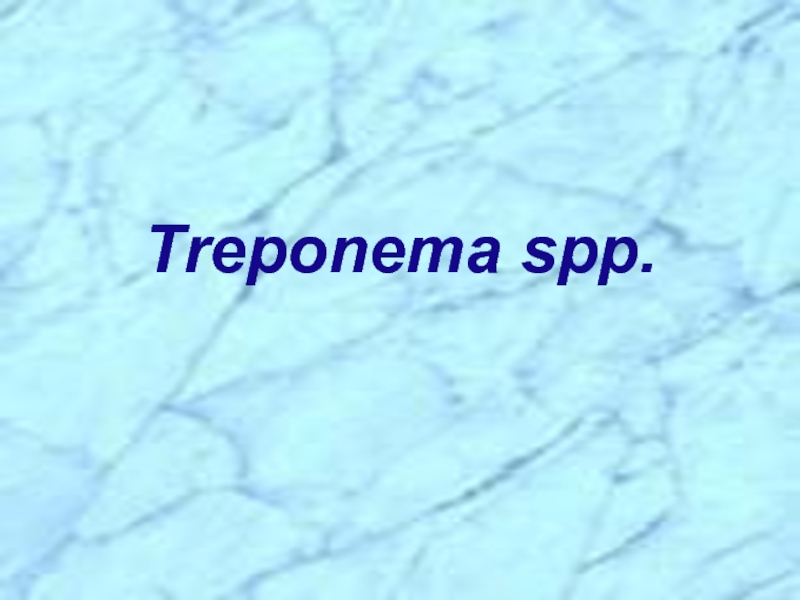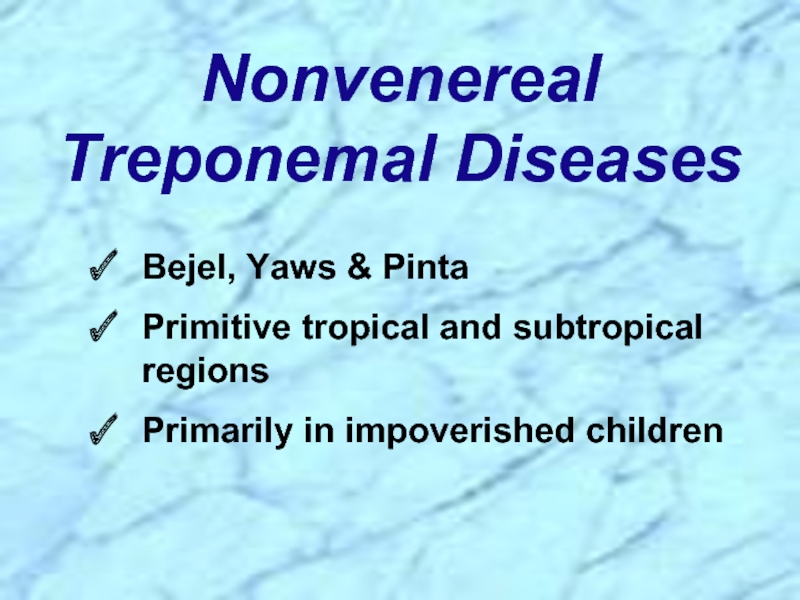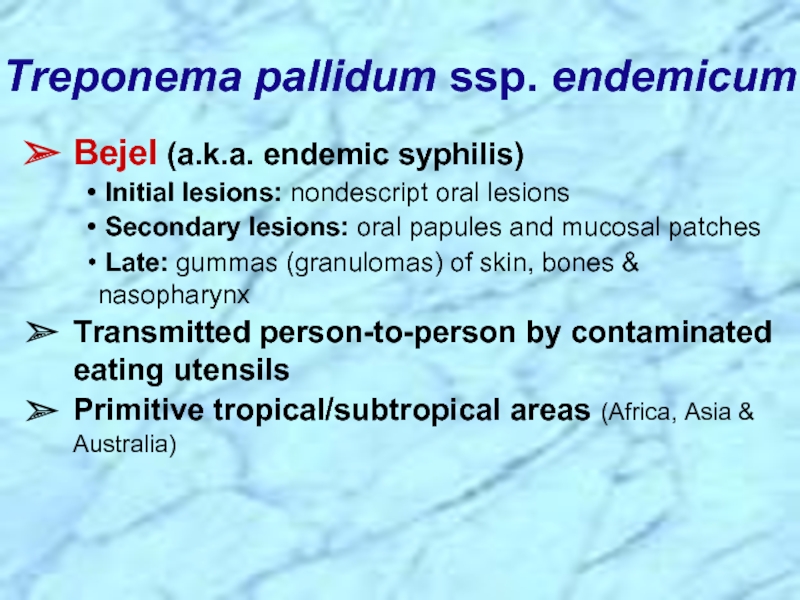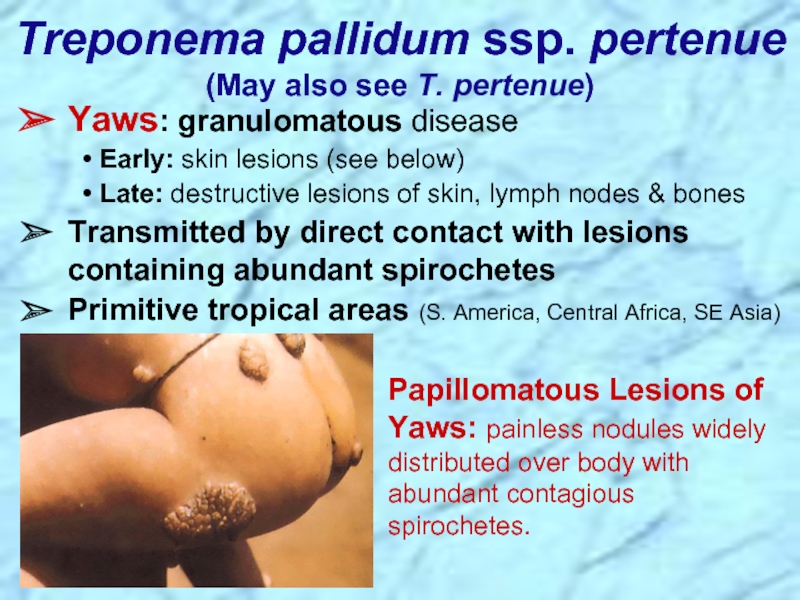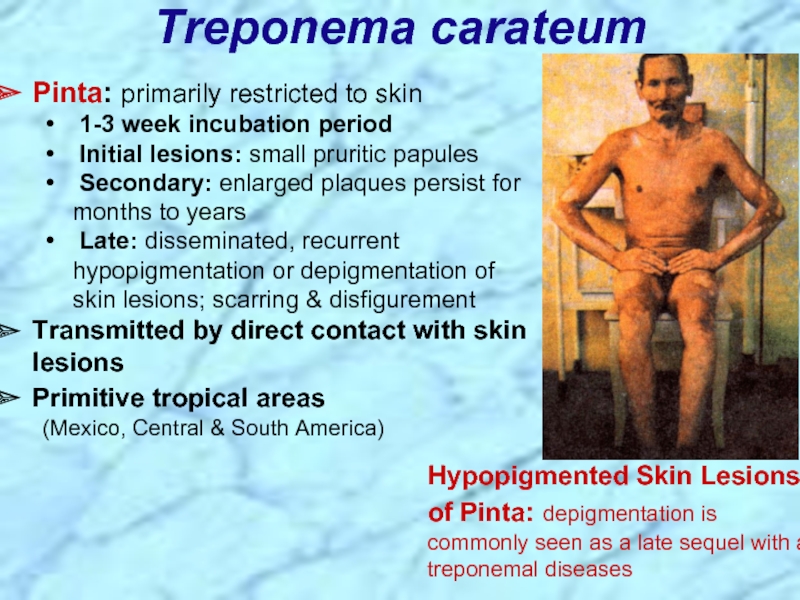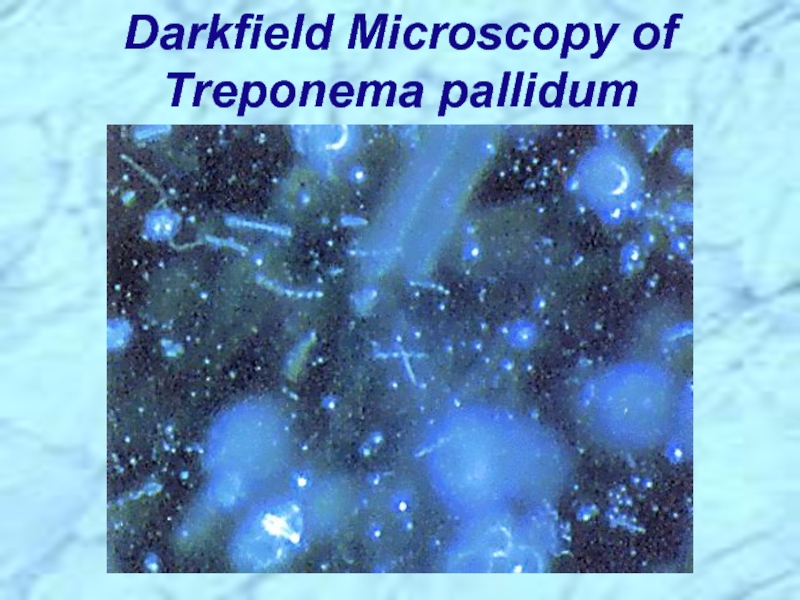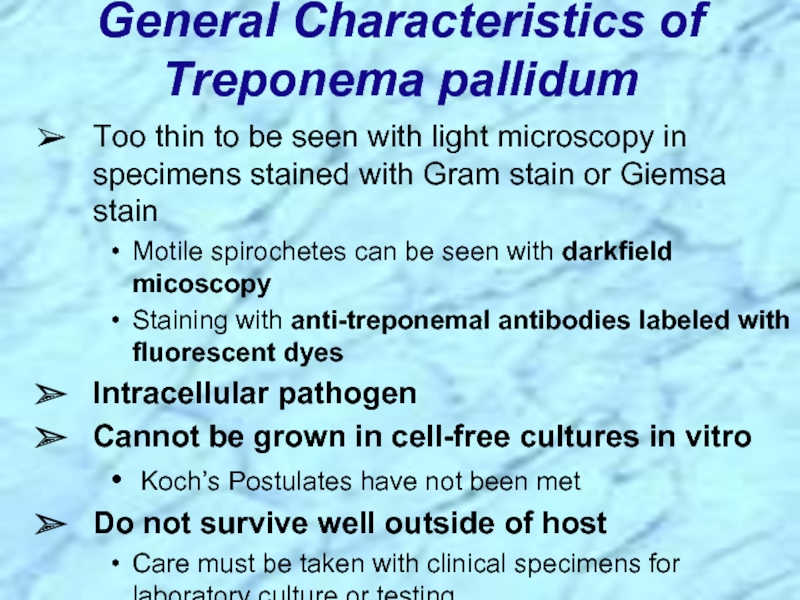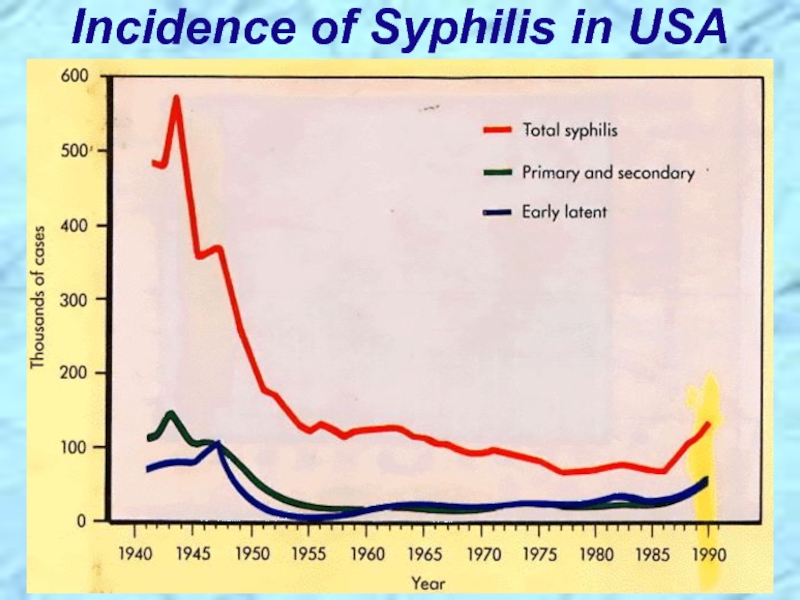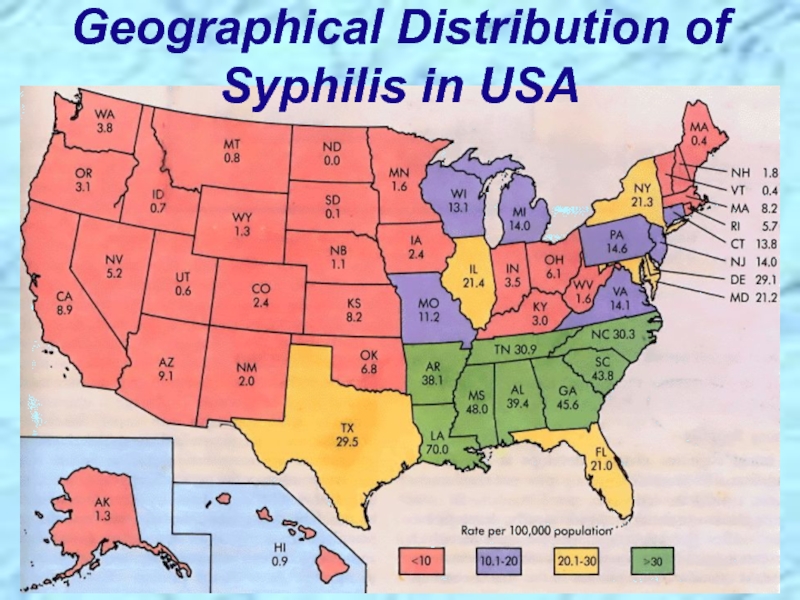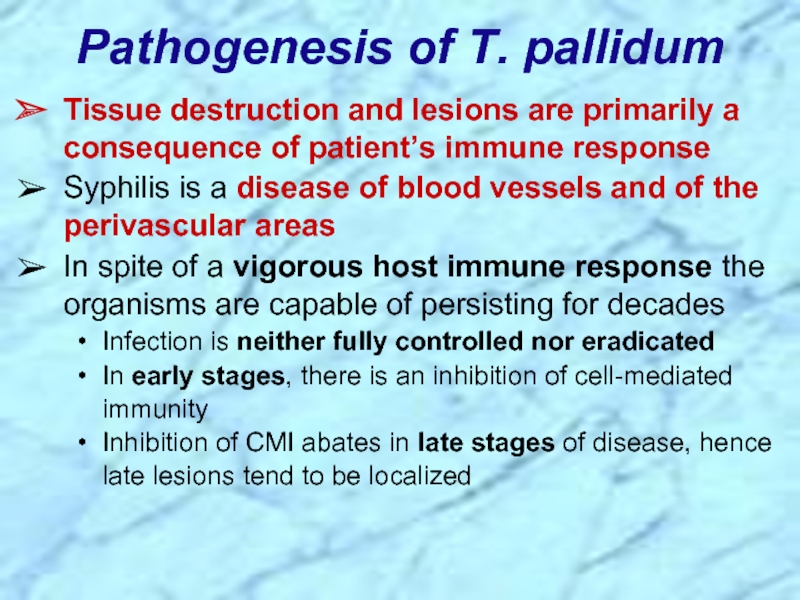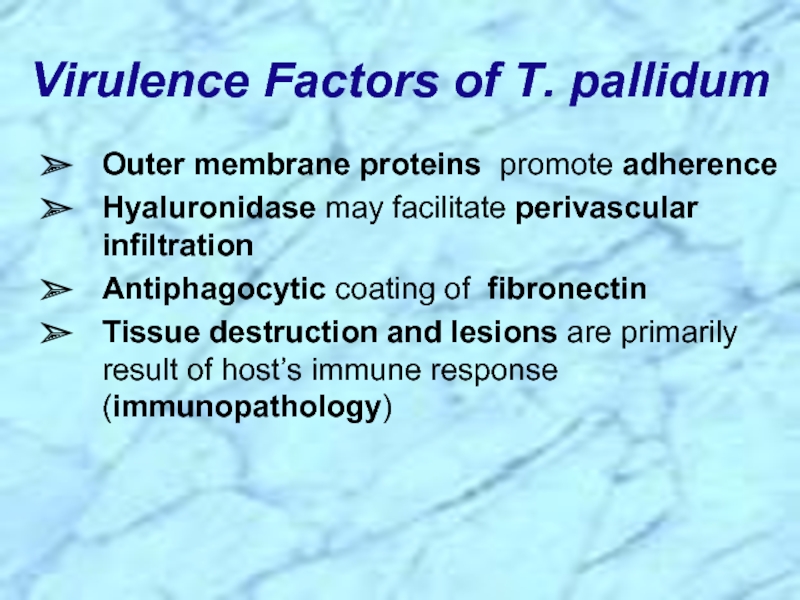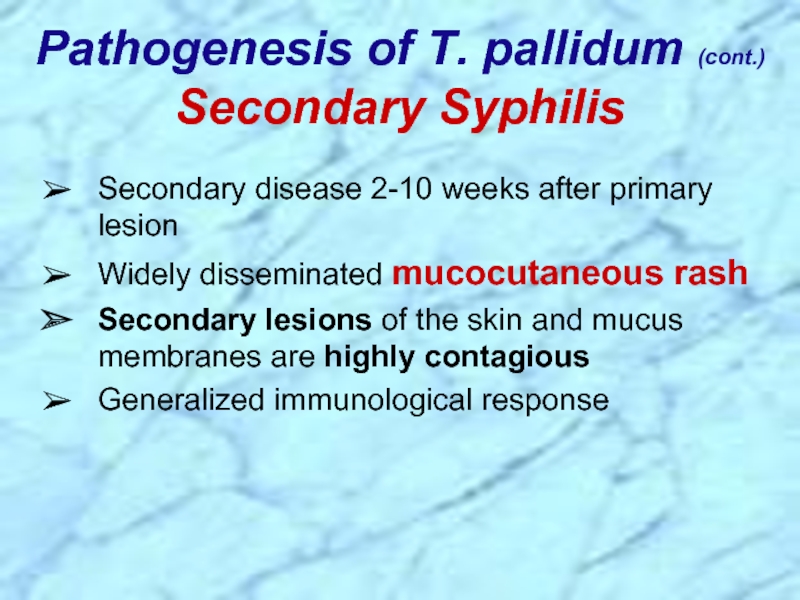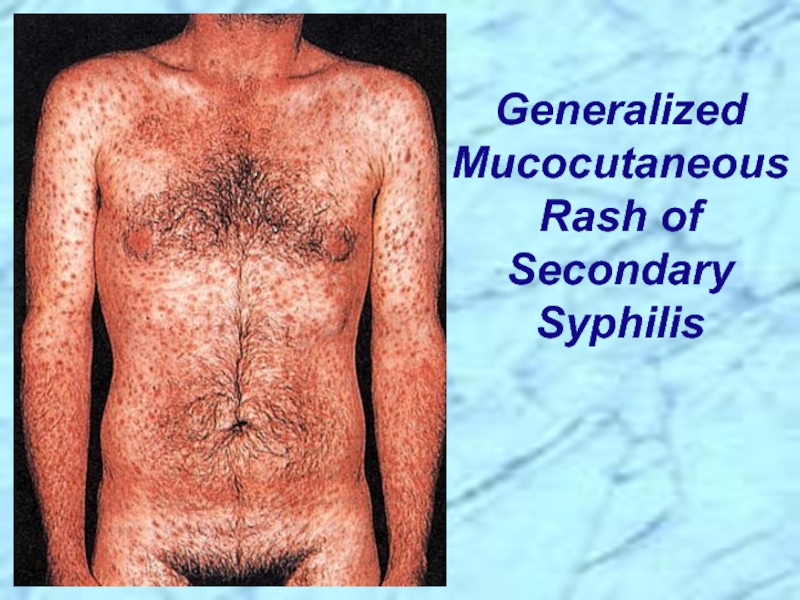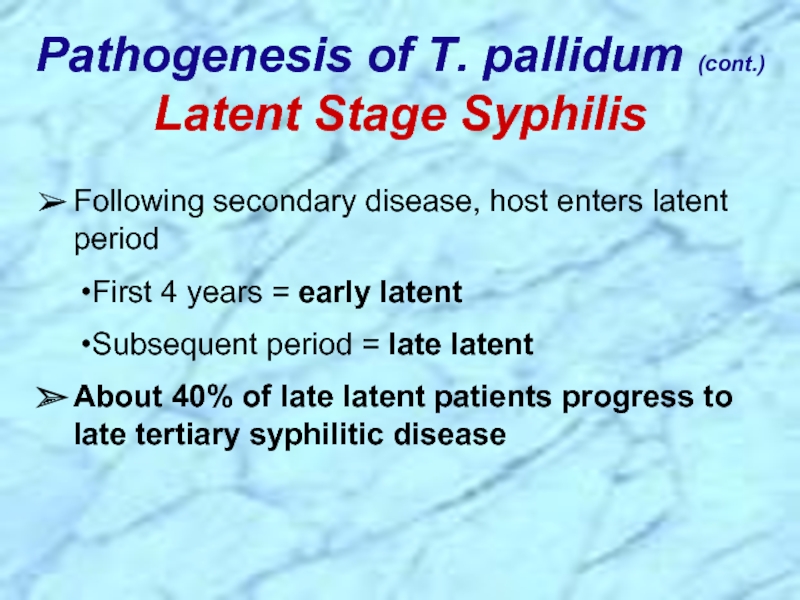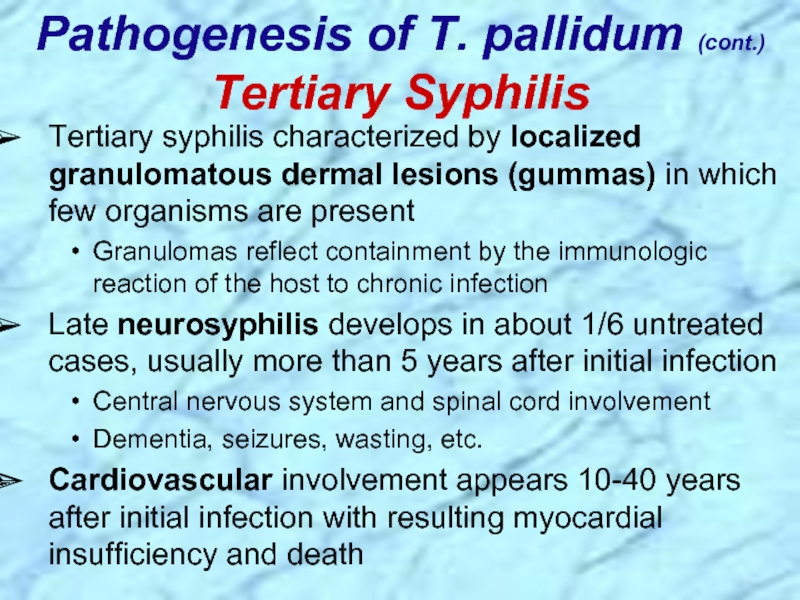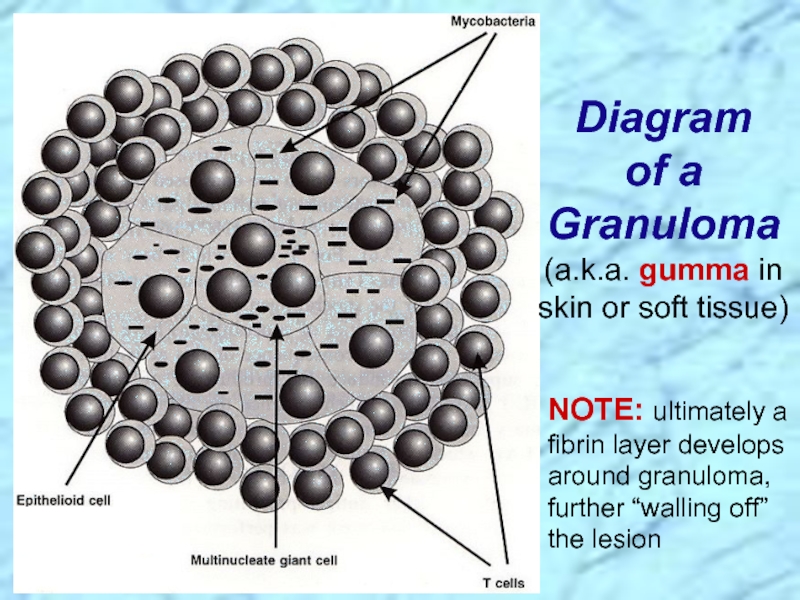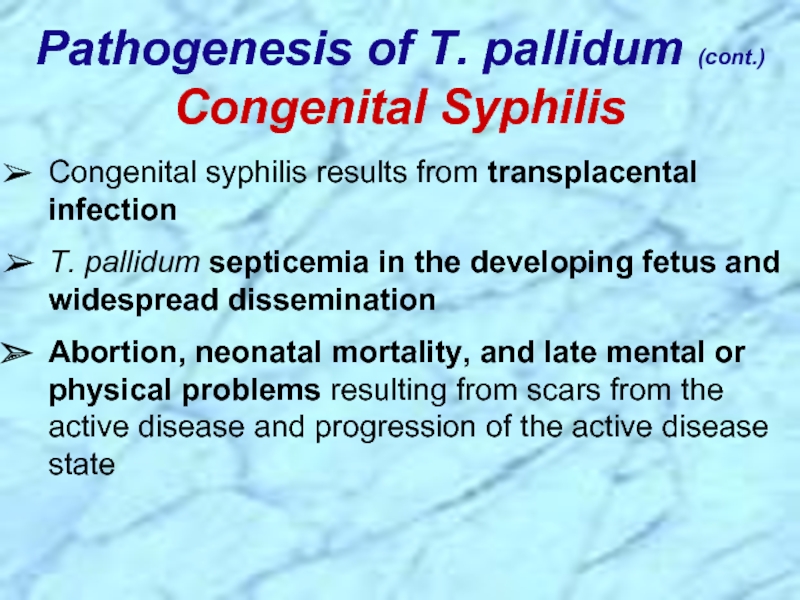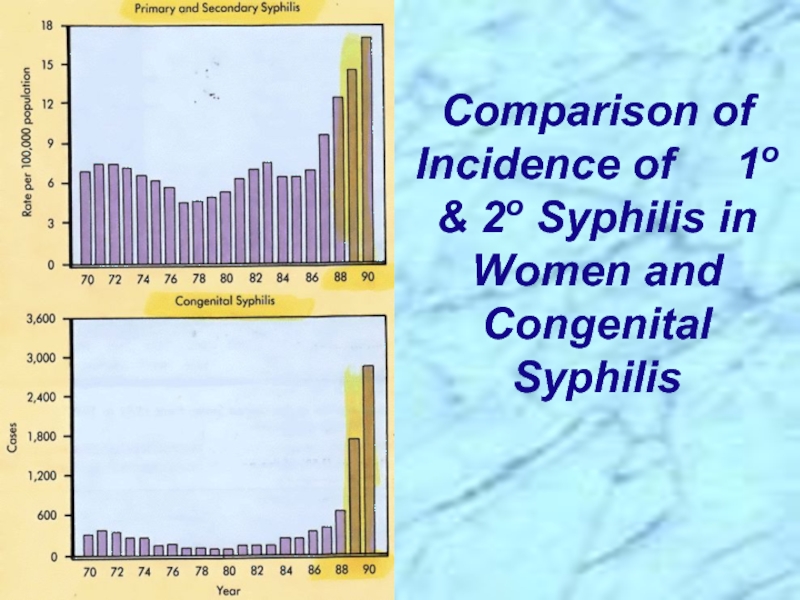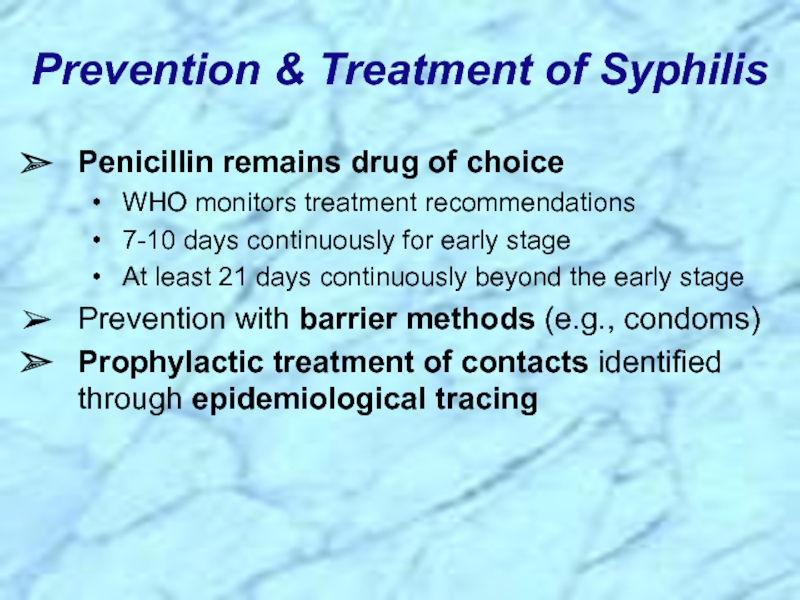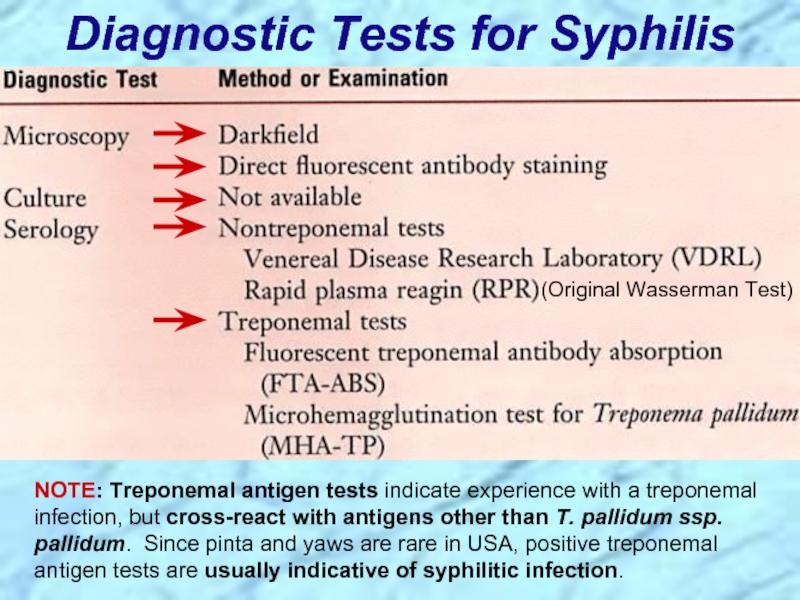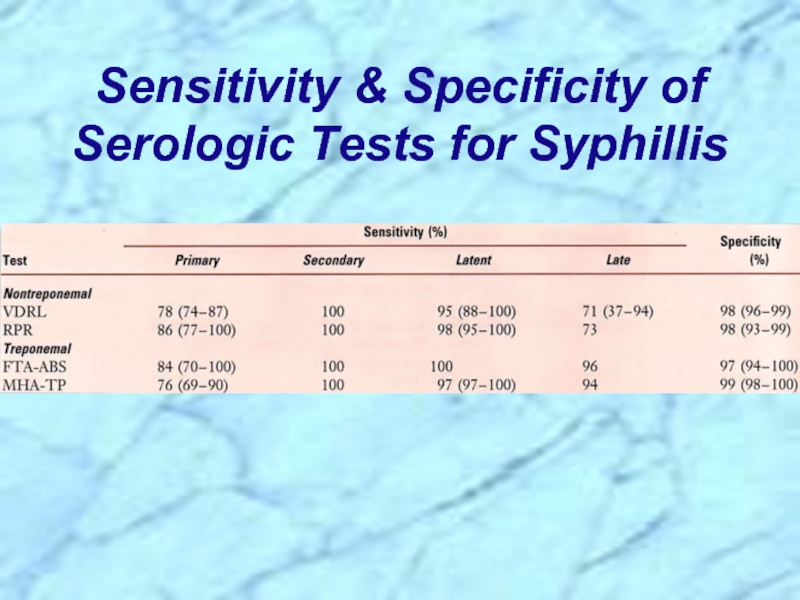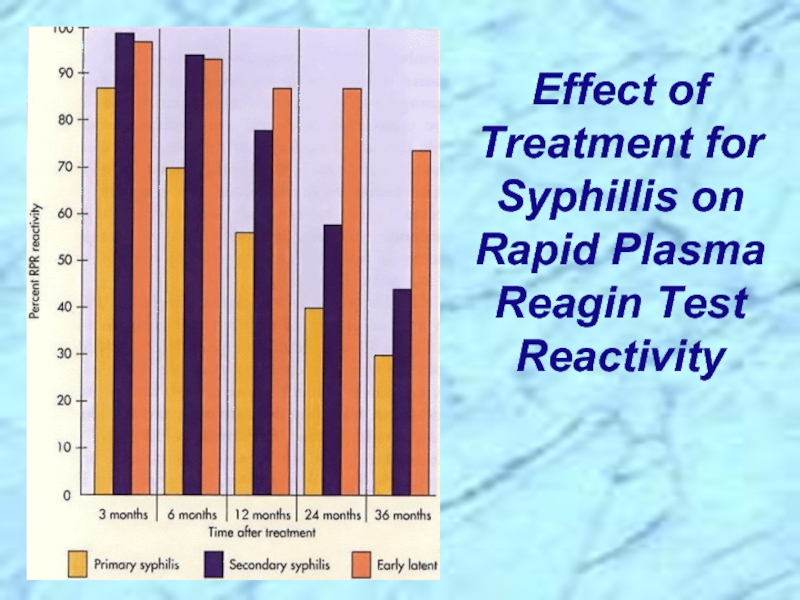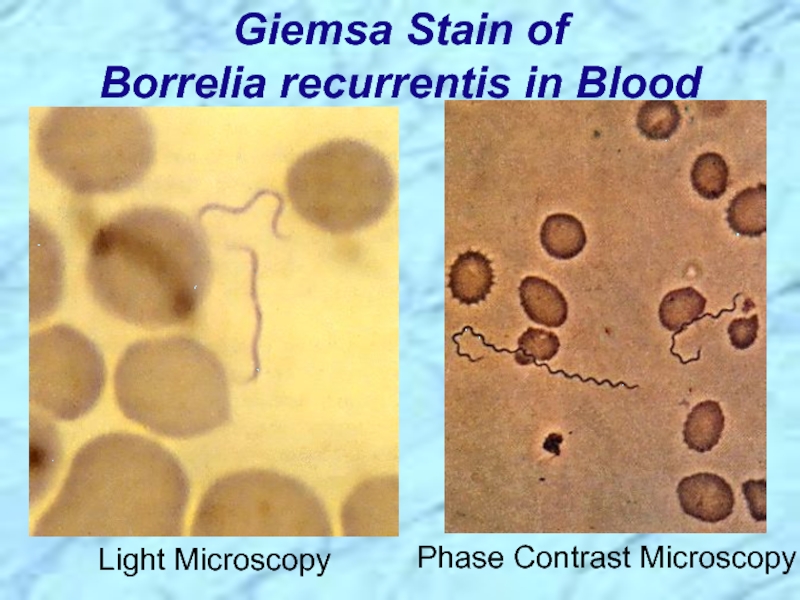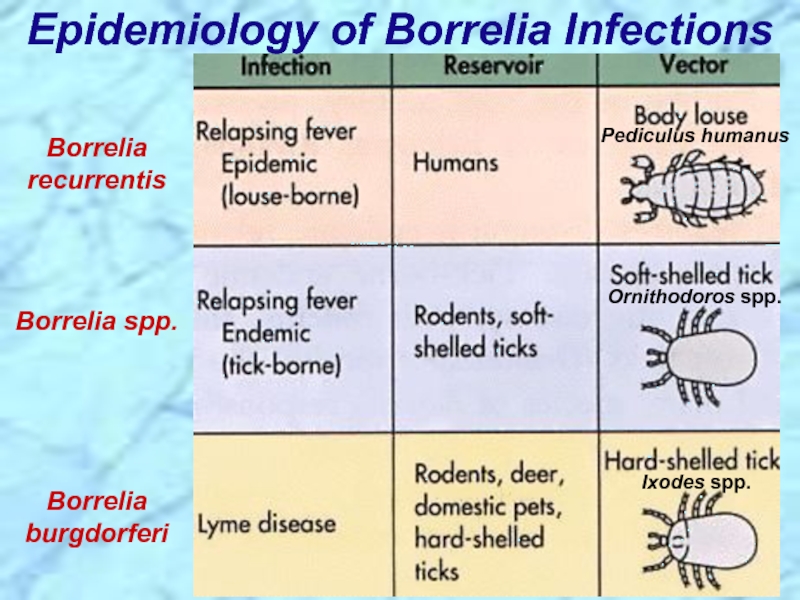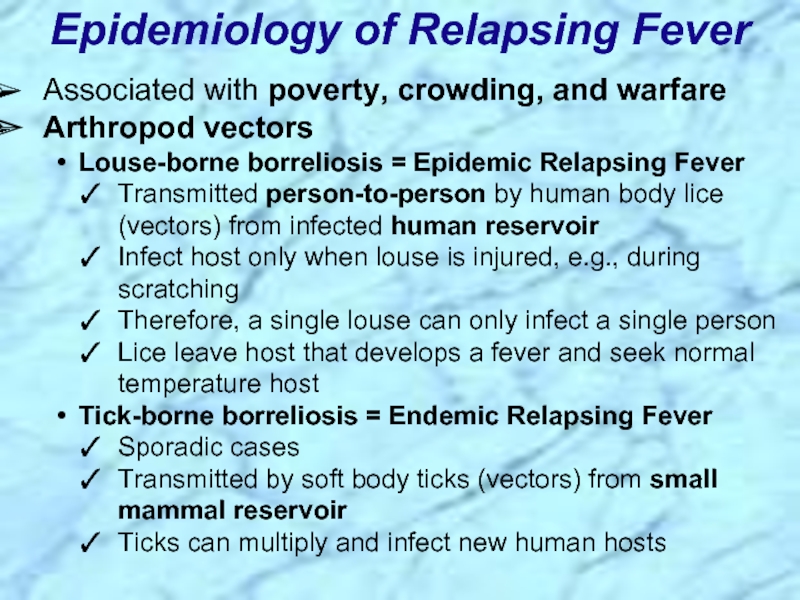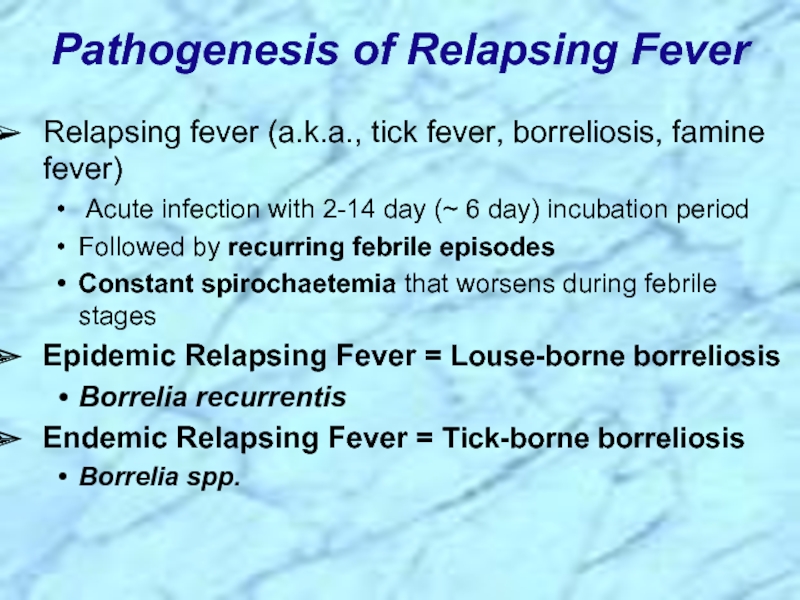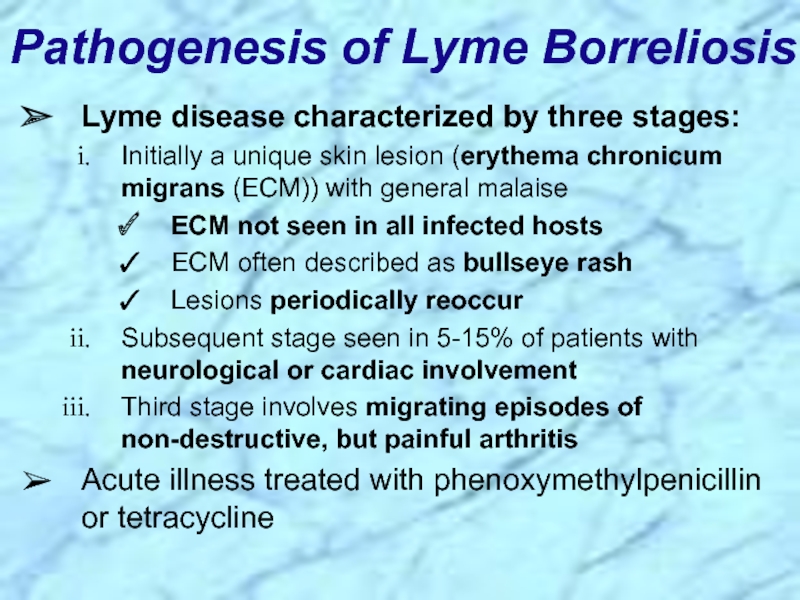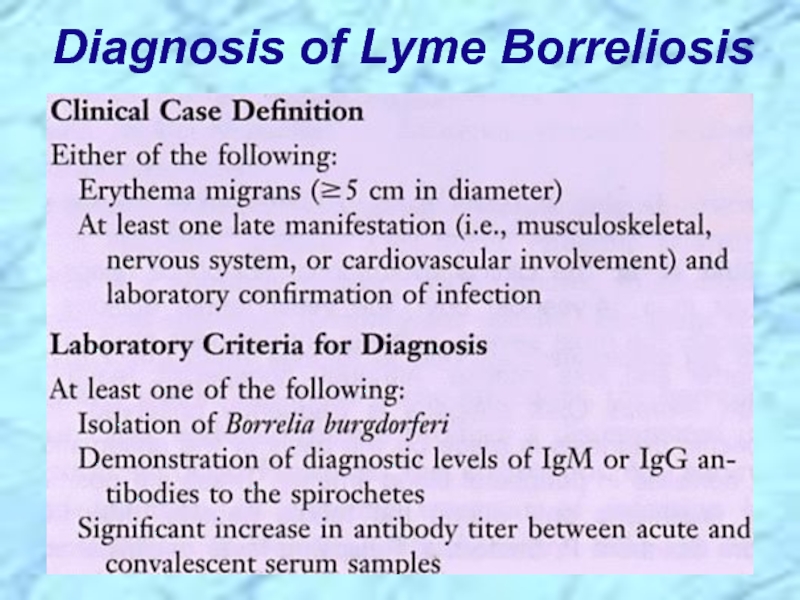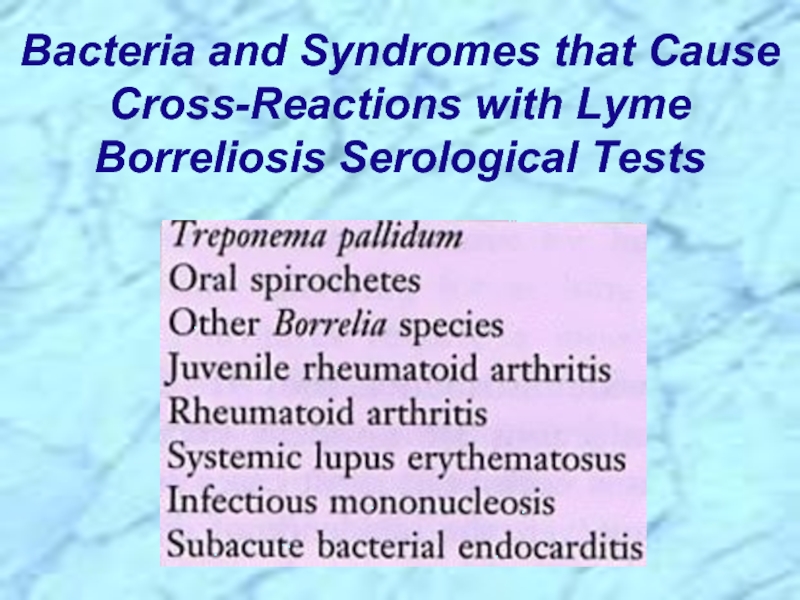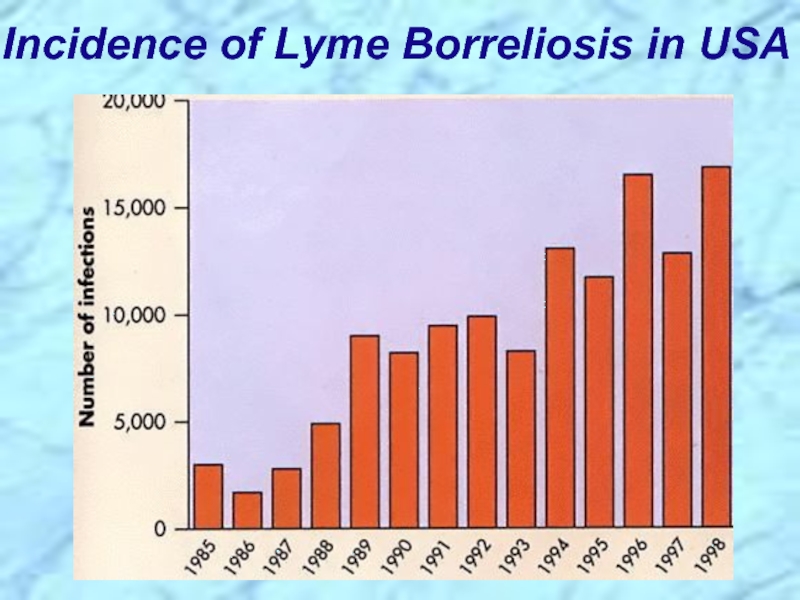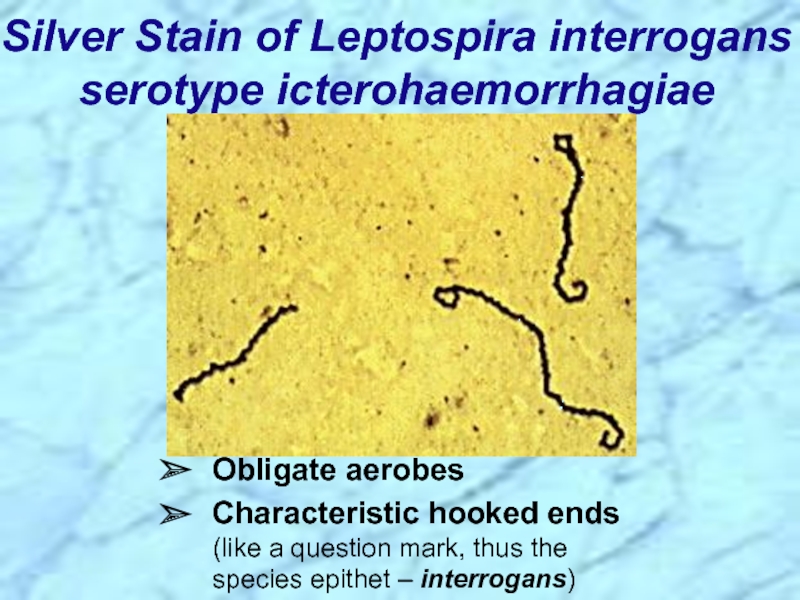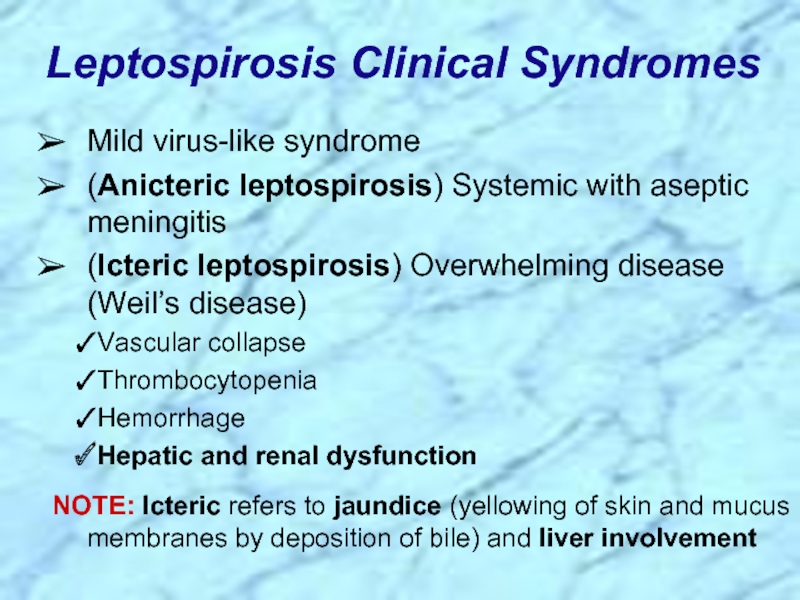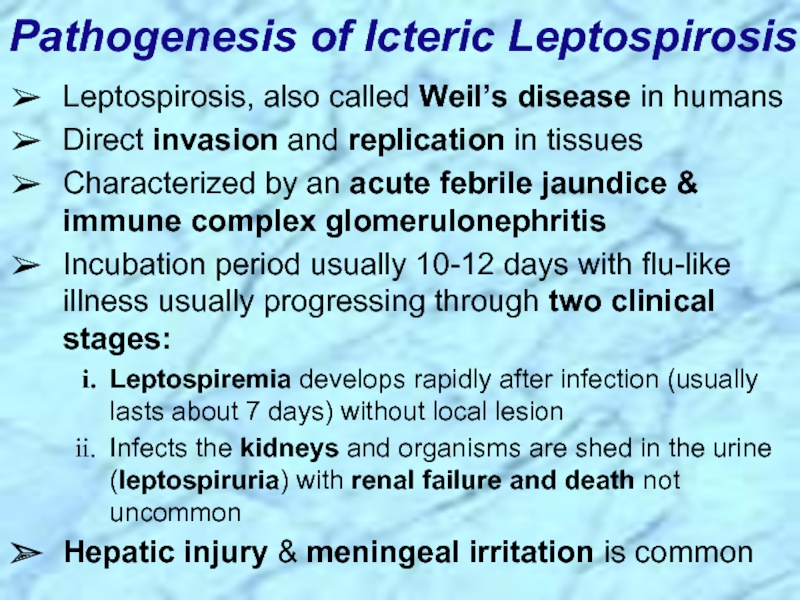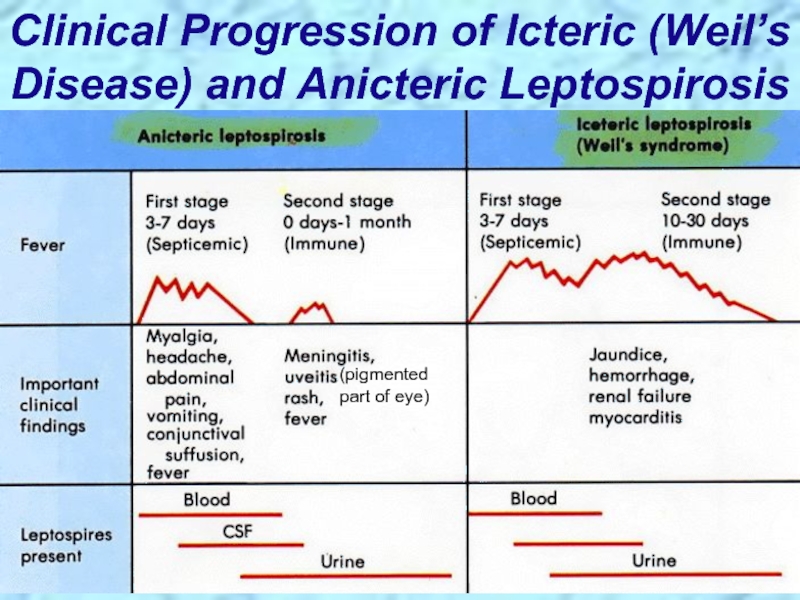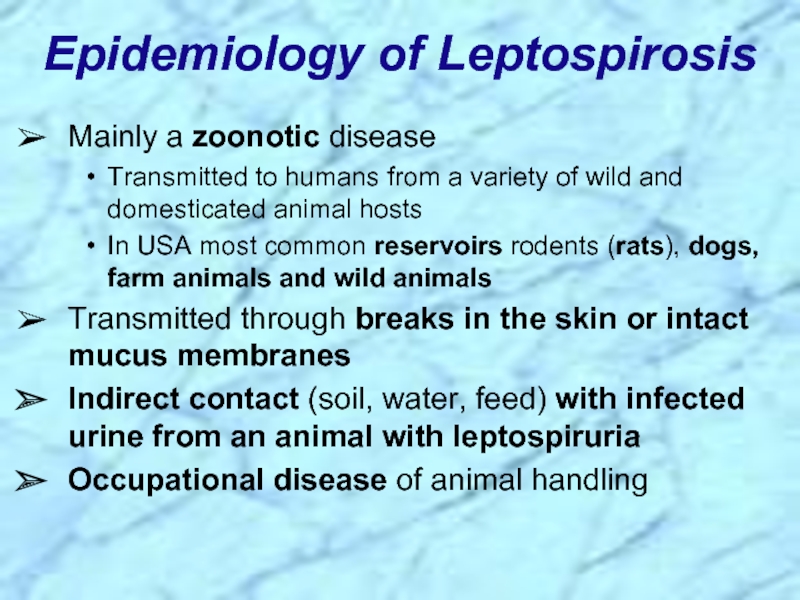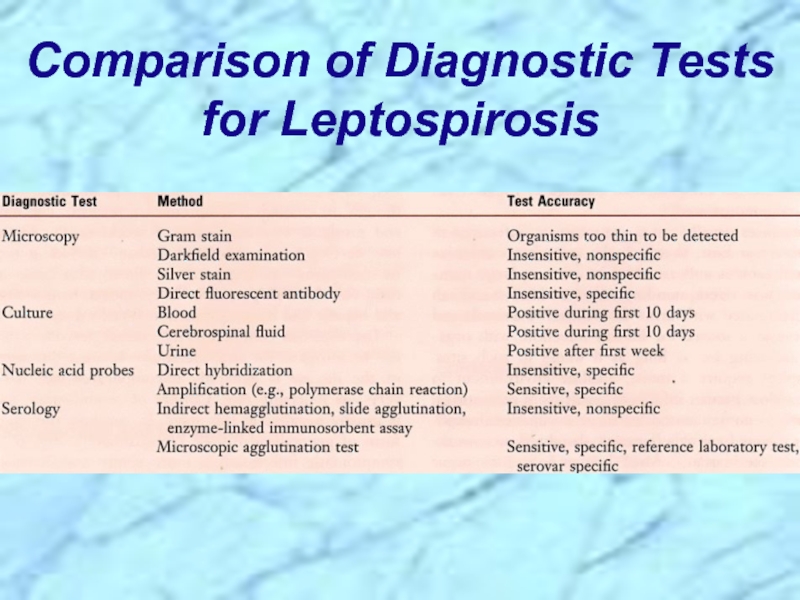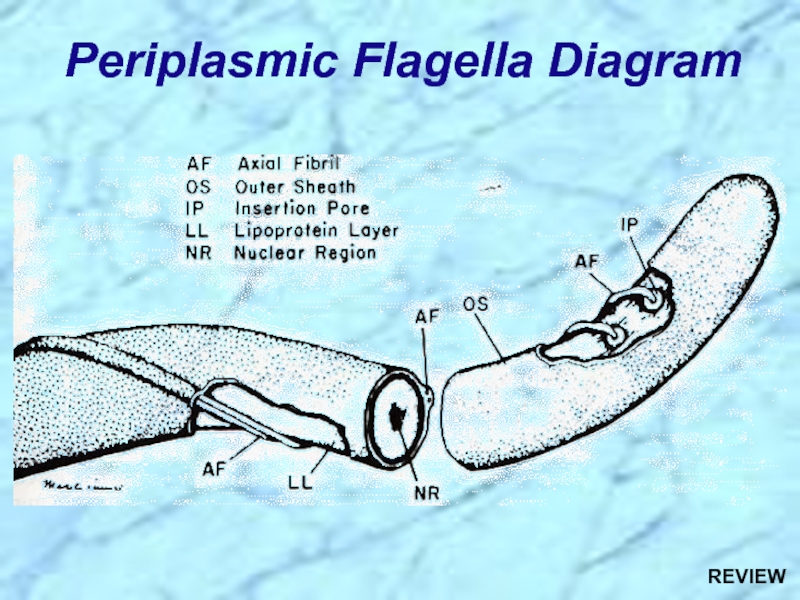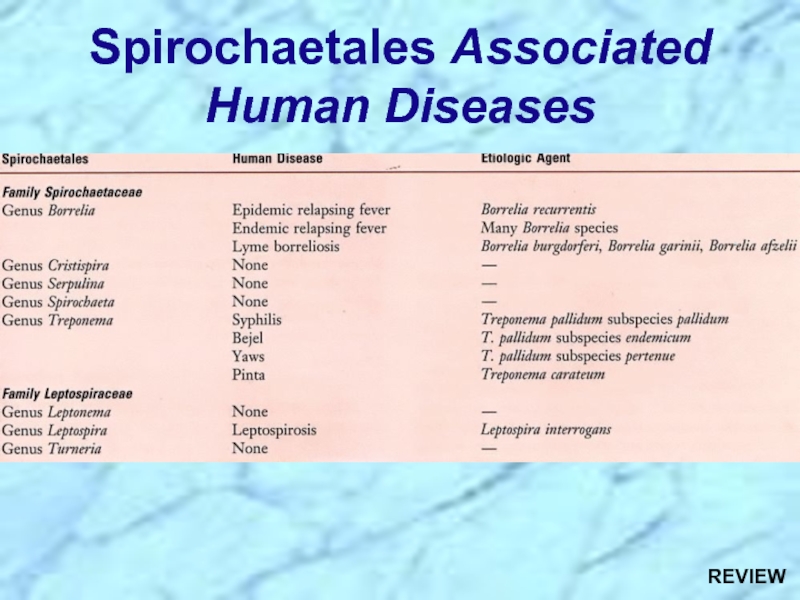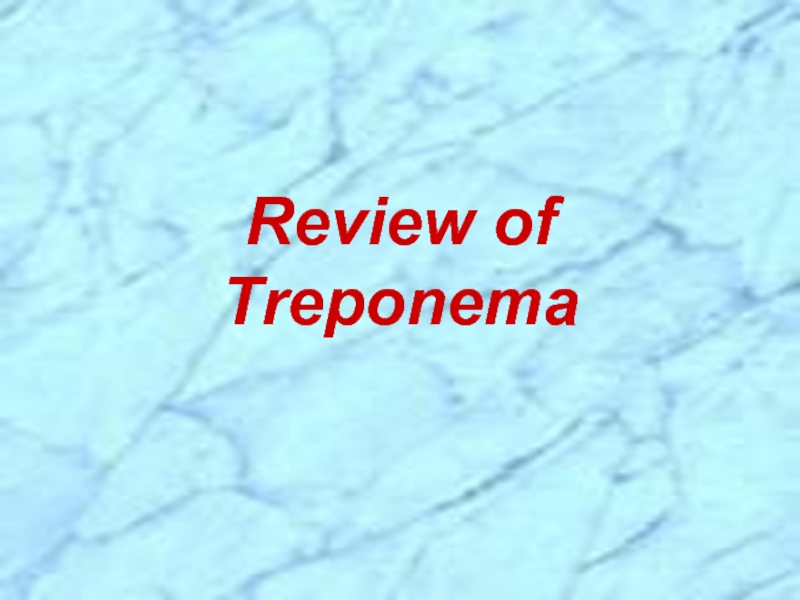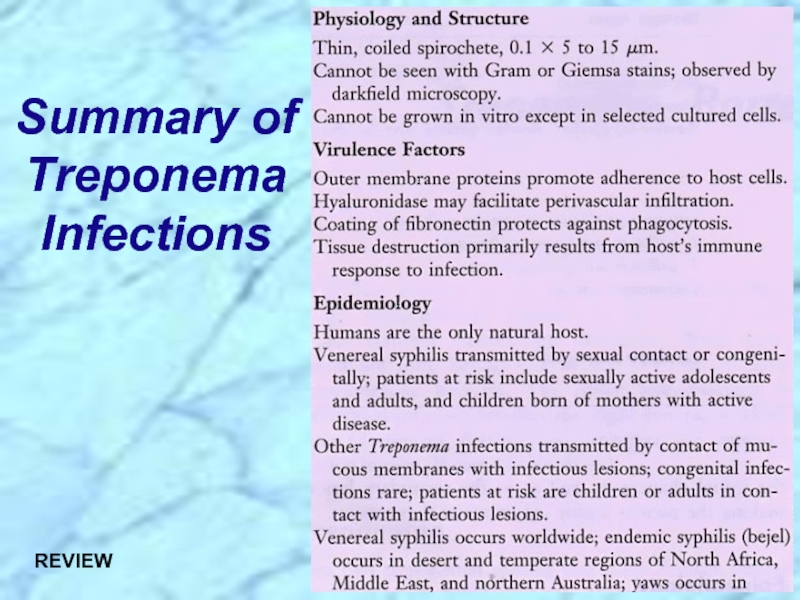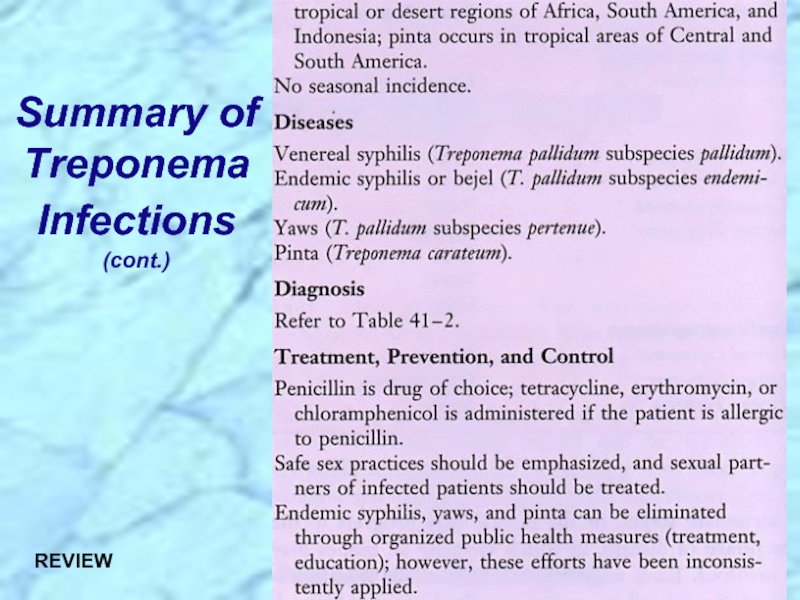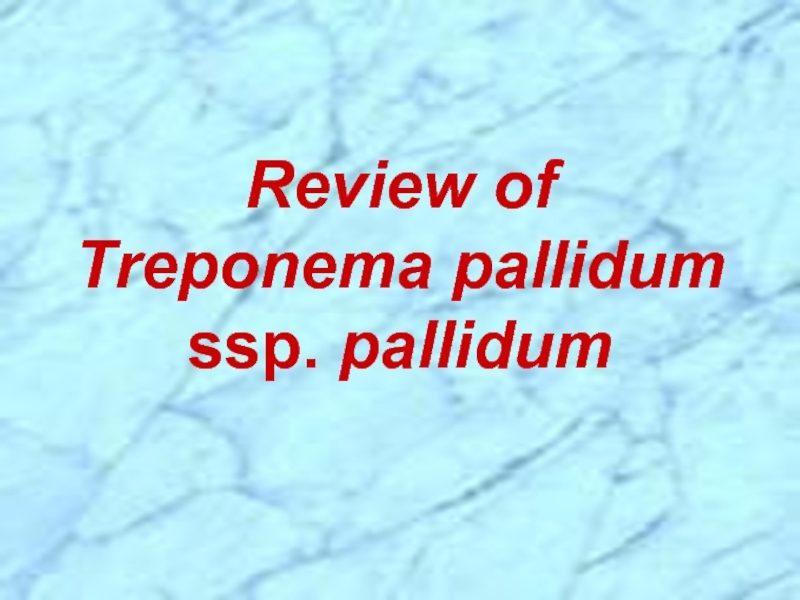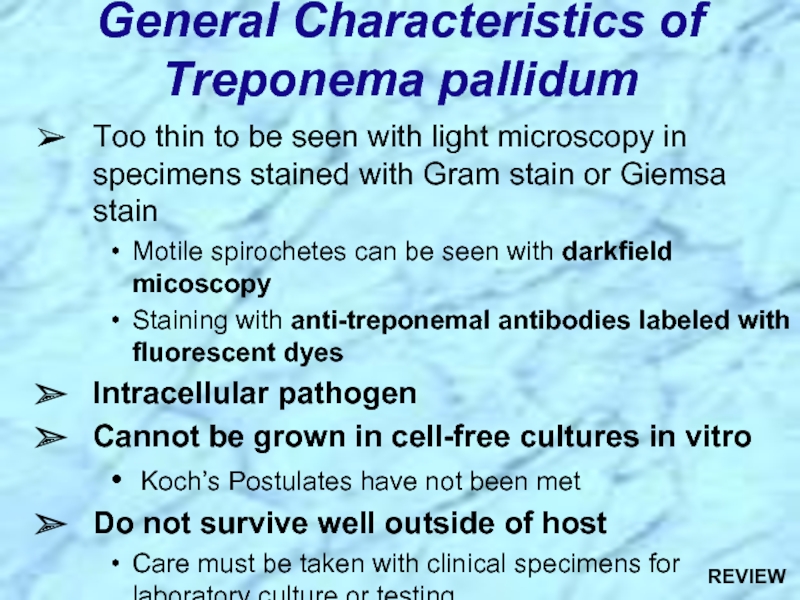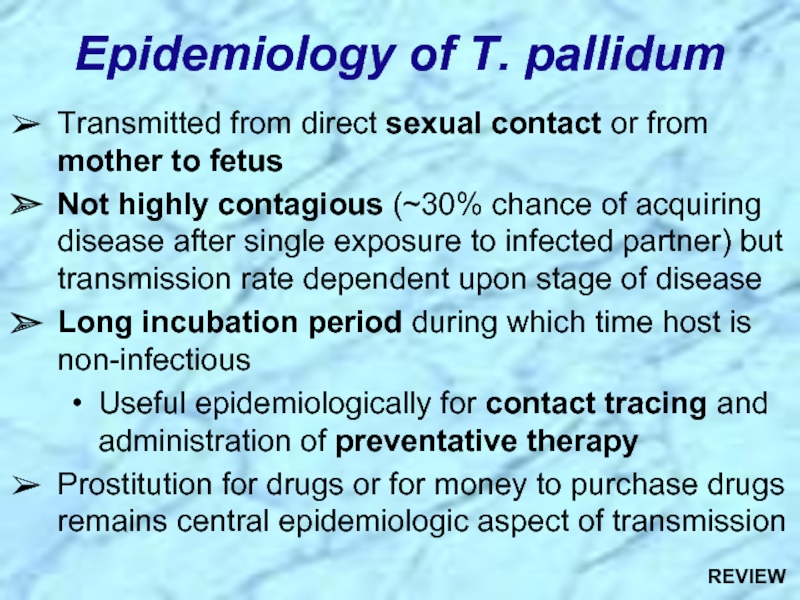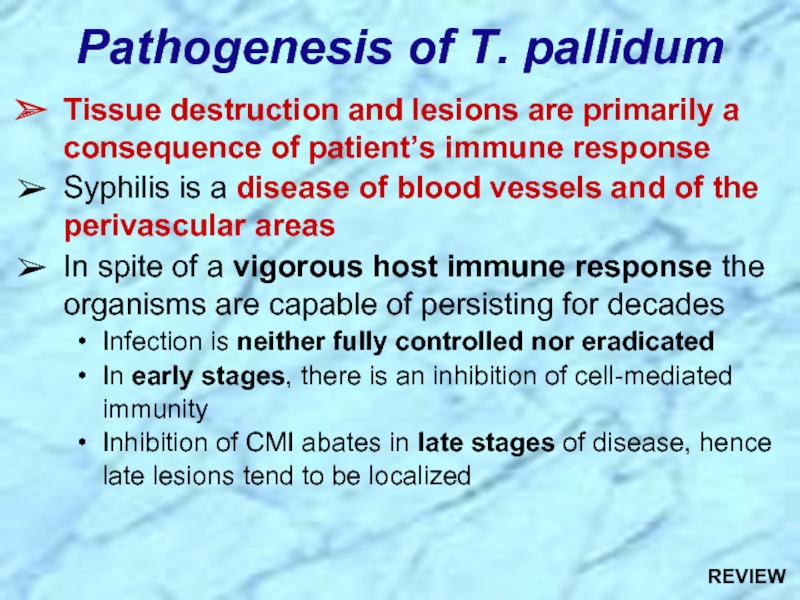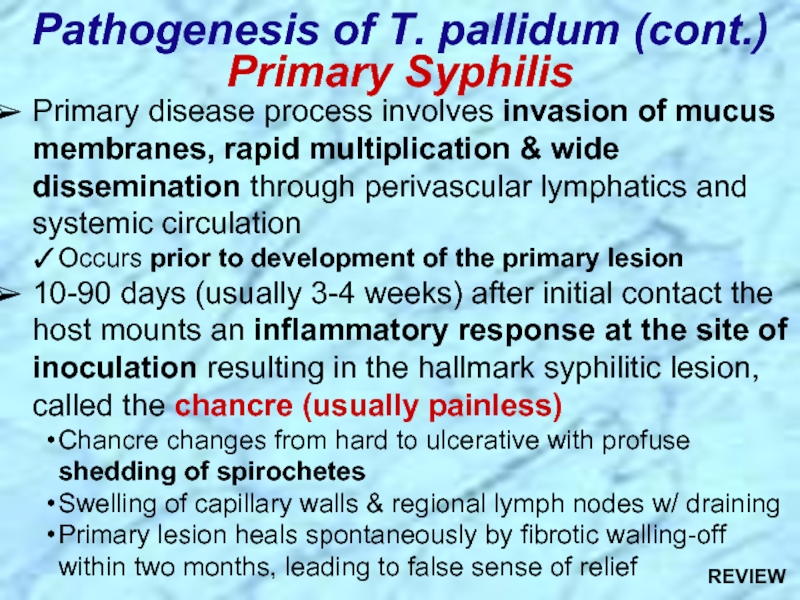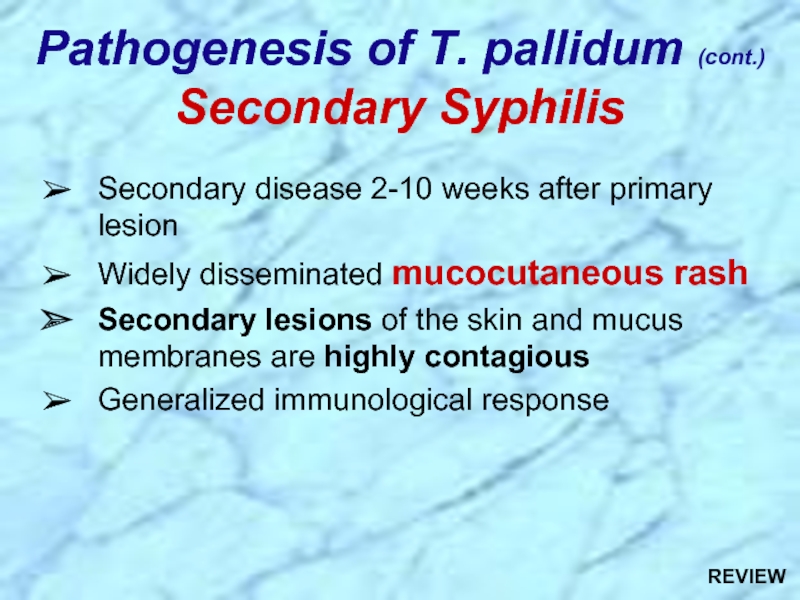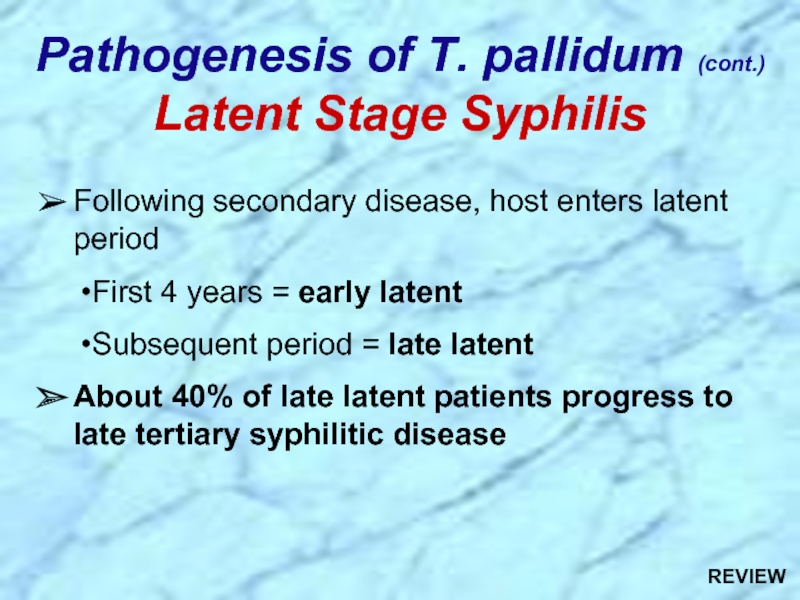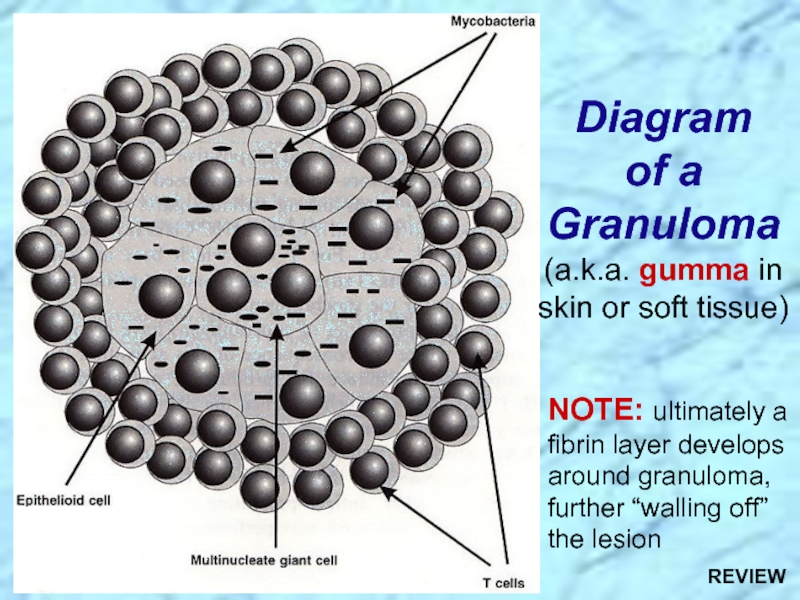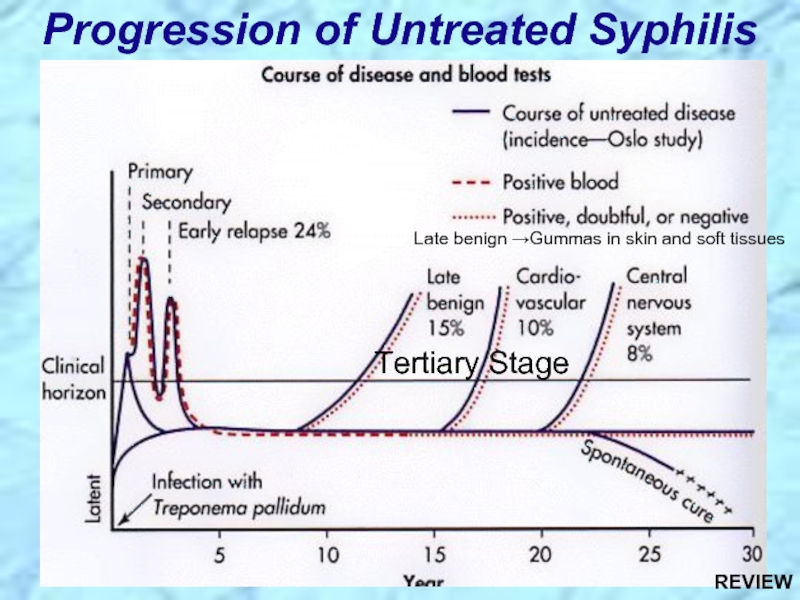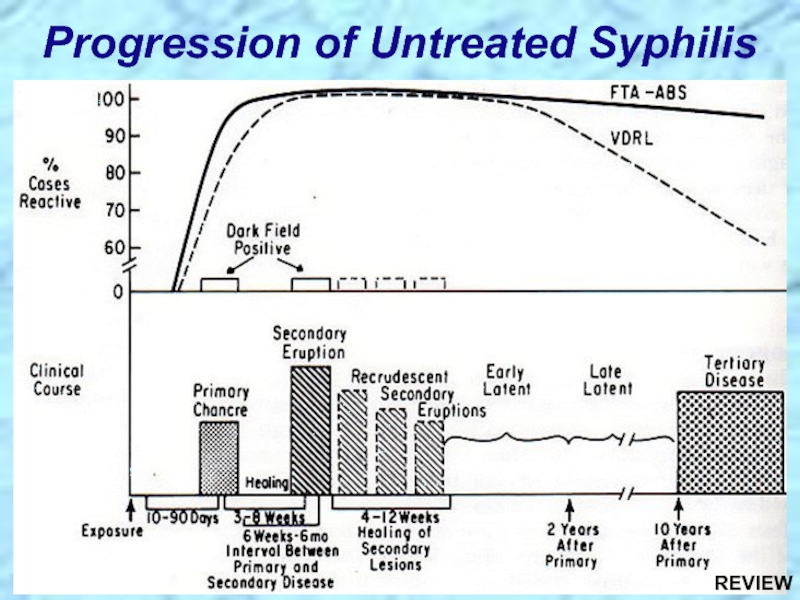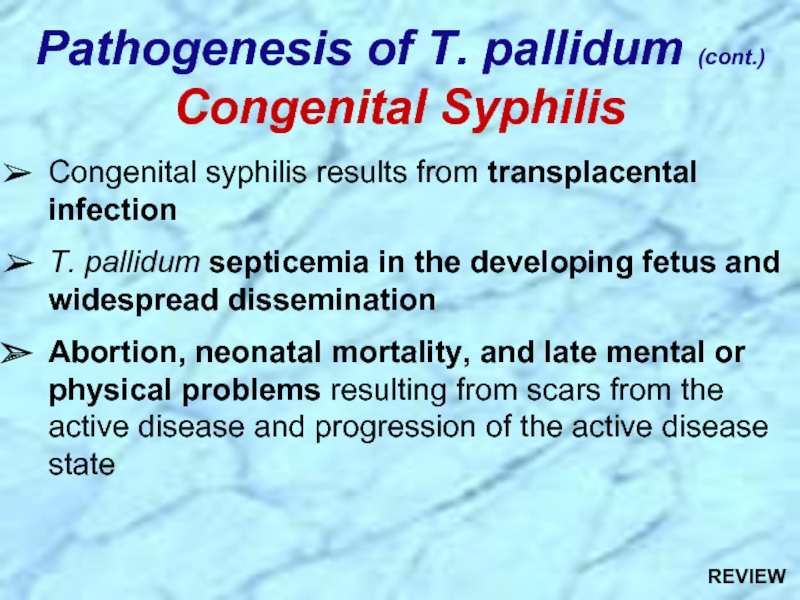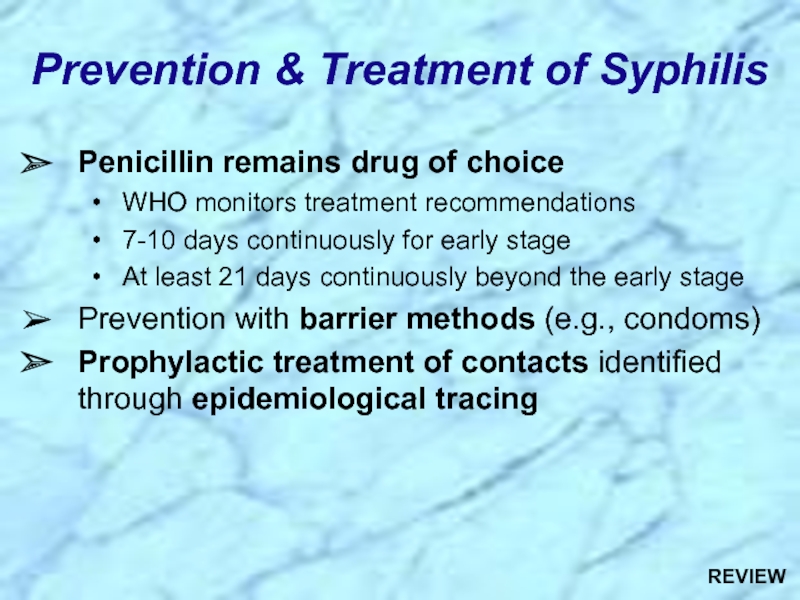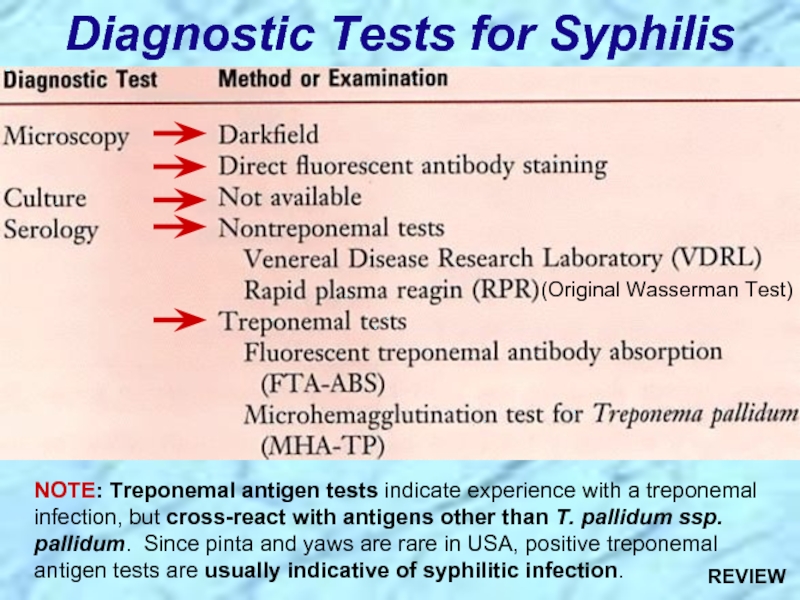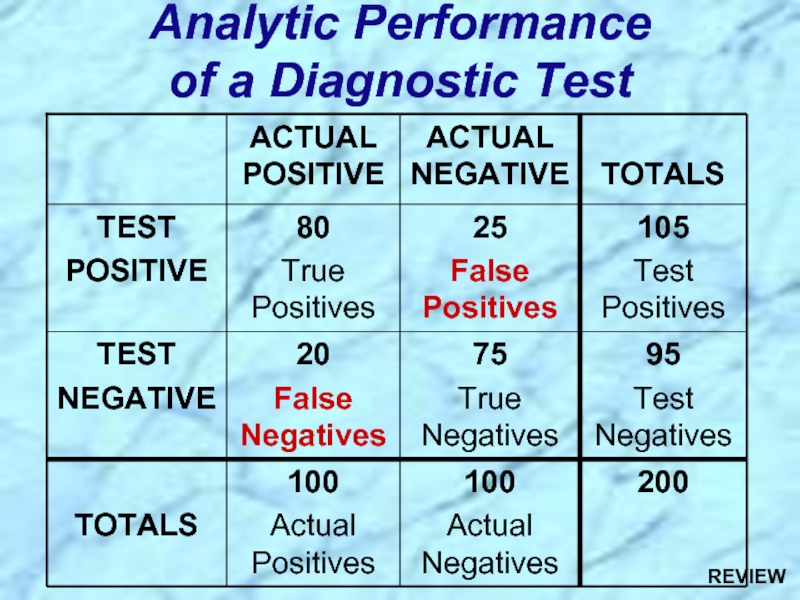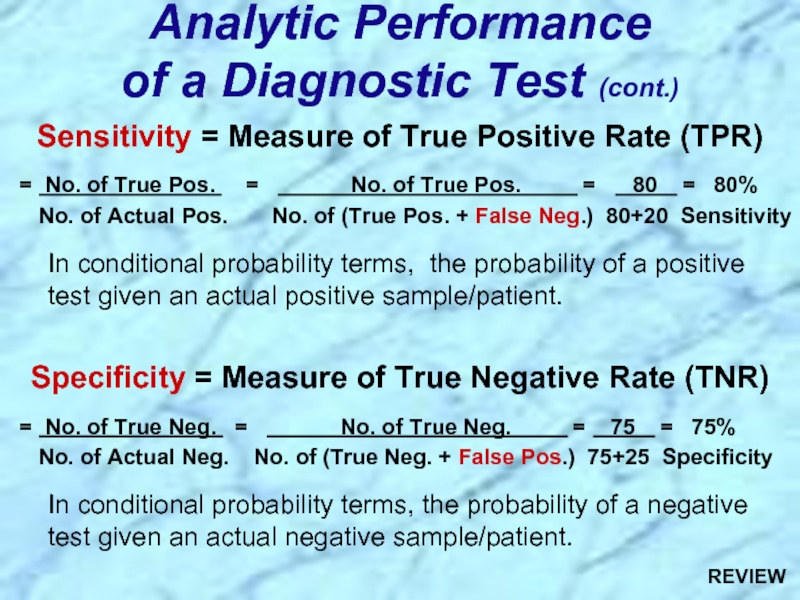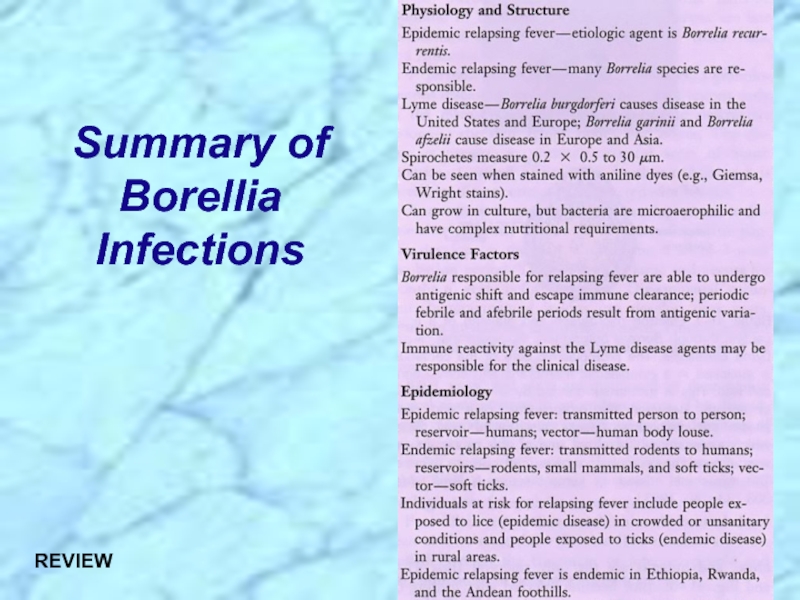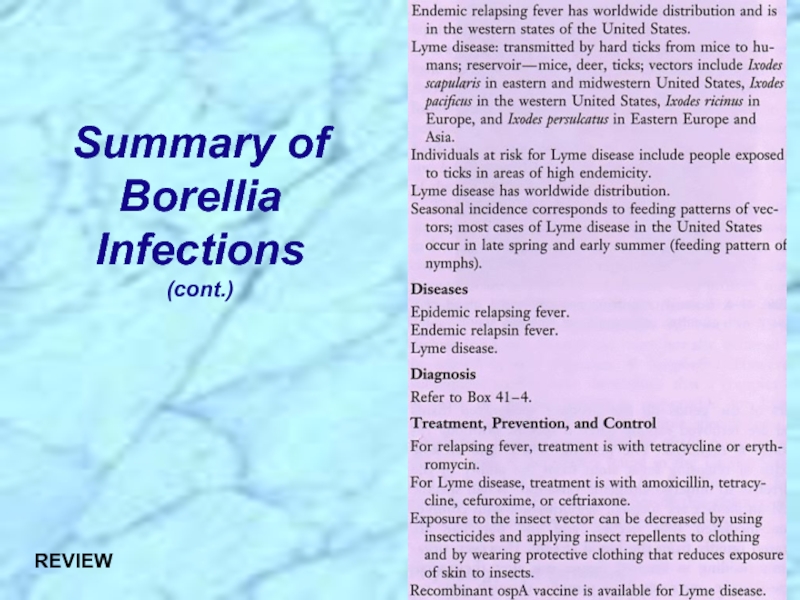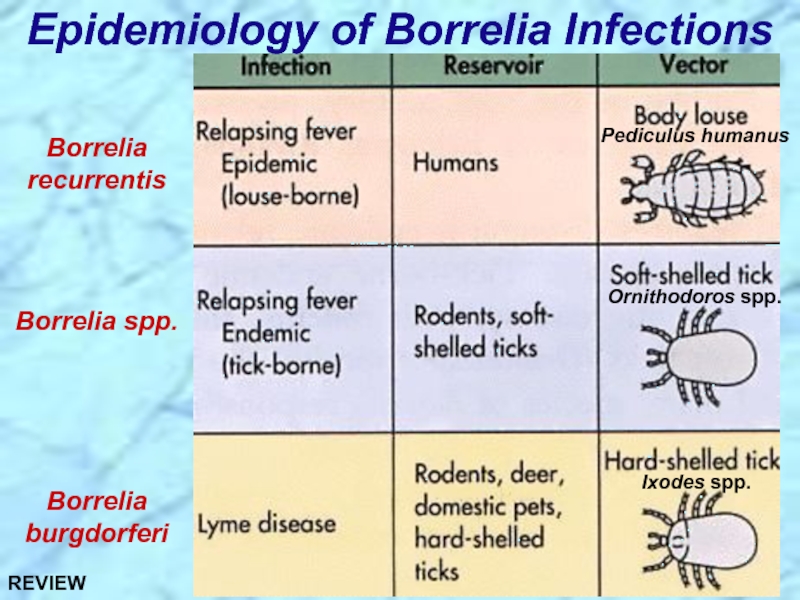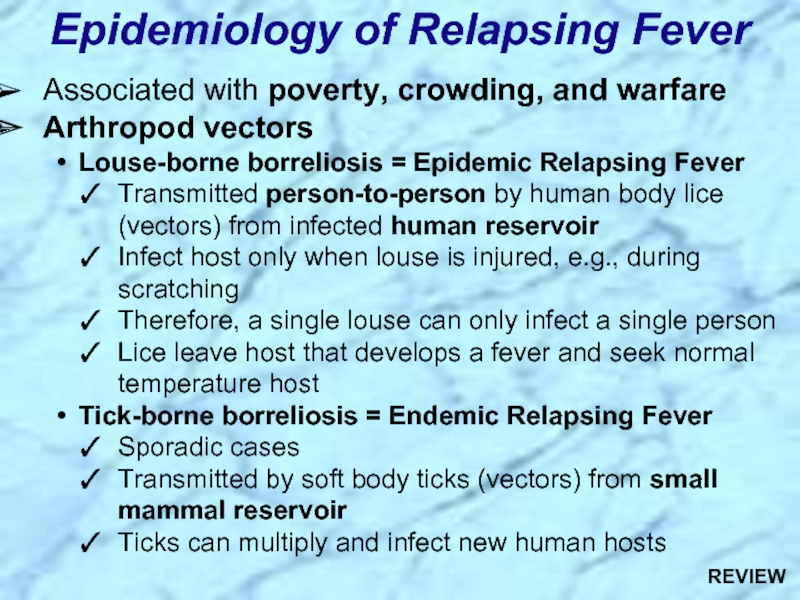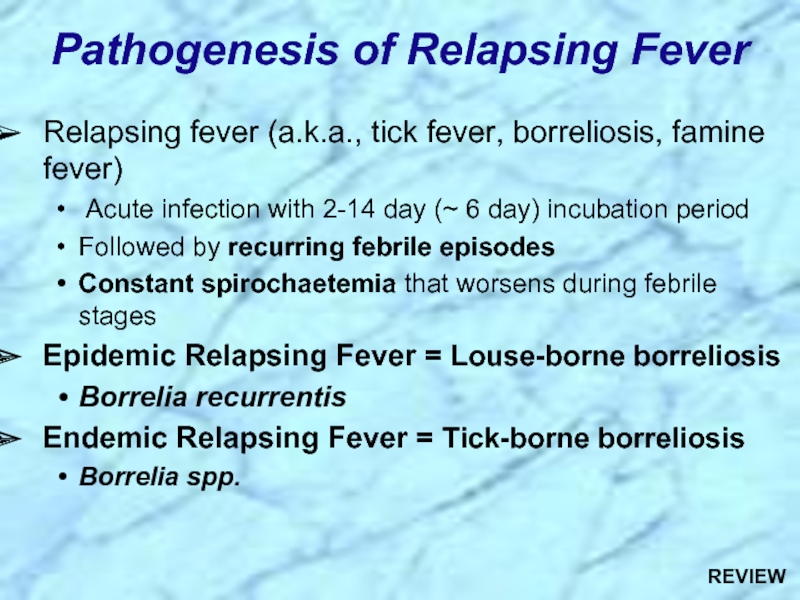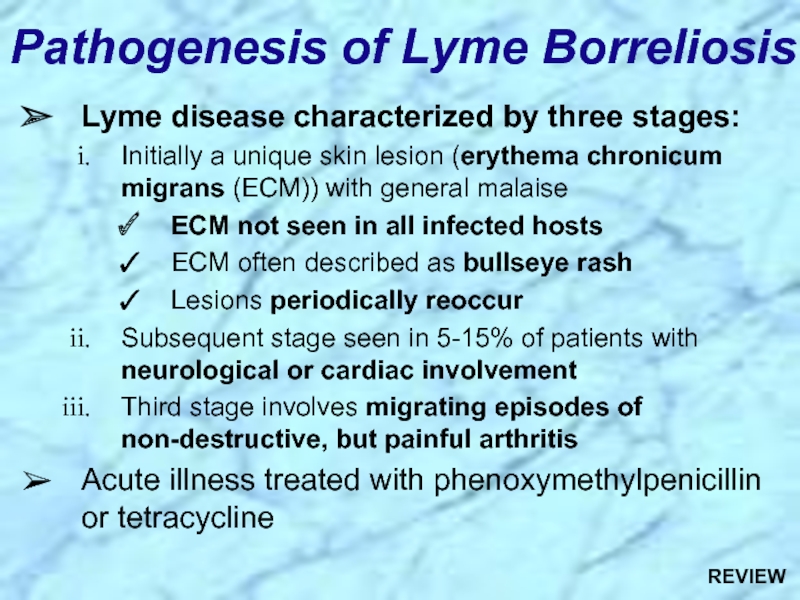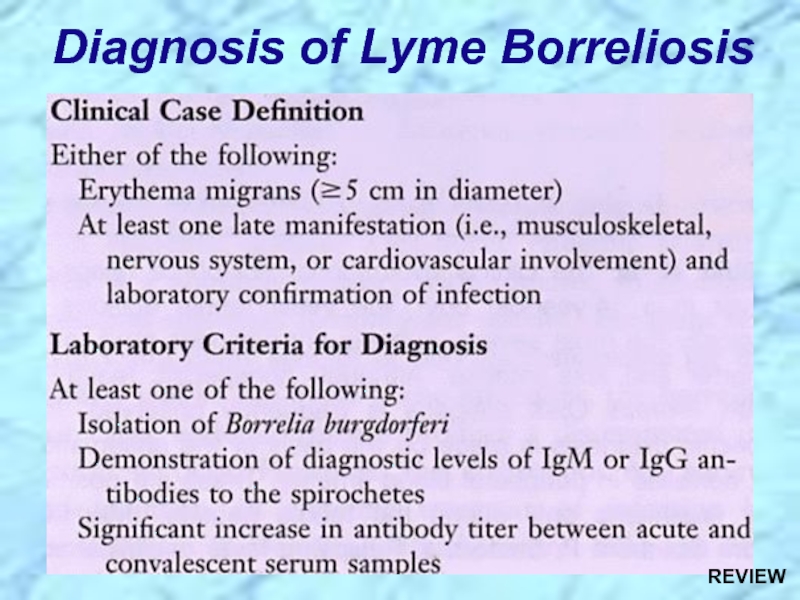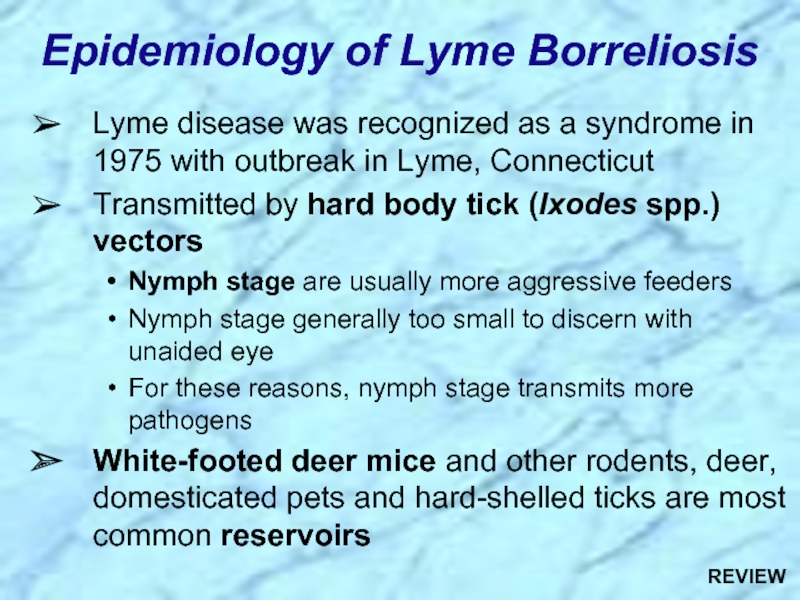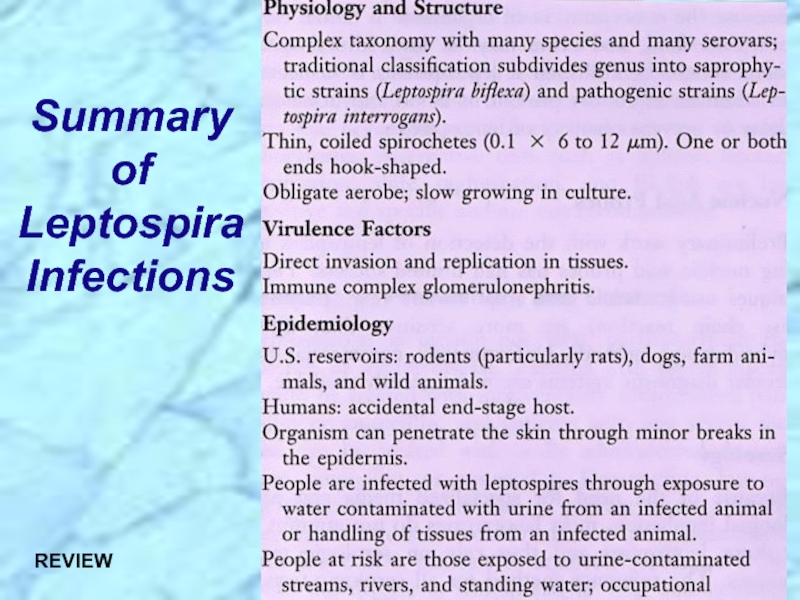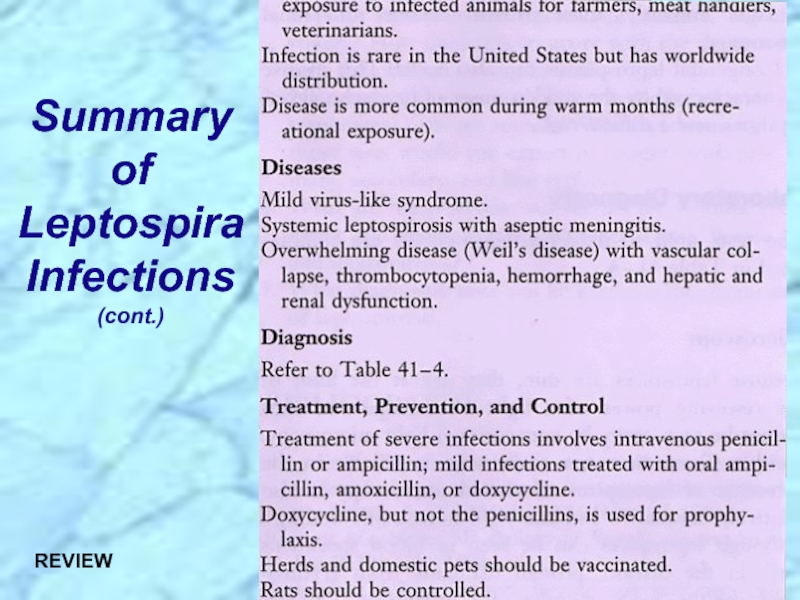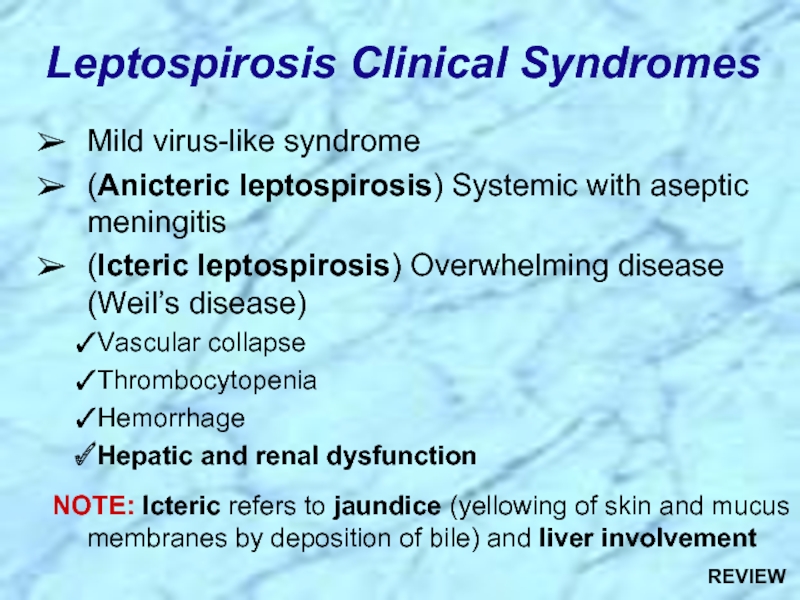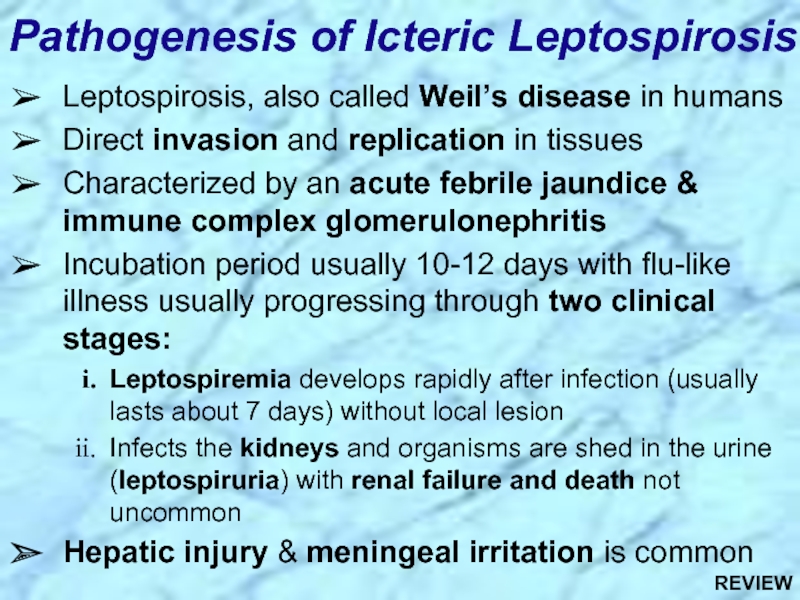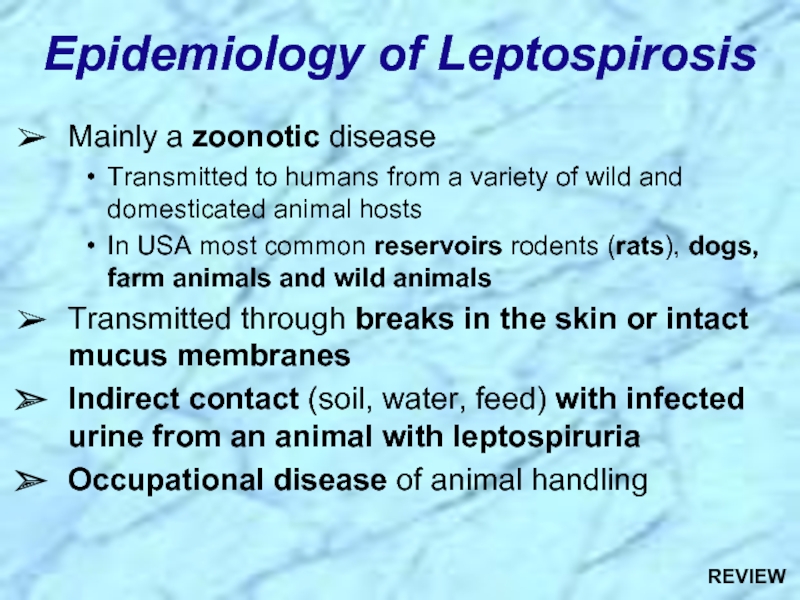- Главная
- Разное
- Дизайн
- Бизнес и предпринимательство
- Аналитика
- Образование
- Развлечения
- Красота и здоровье
- Финансы
- Государство
- Путешествия
- Спорт
- Недвижимость
- Армия
- Графика
- Культурология
- Еда и кулинария
- Лингвистика
- Английский язык
- Астрономия
- Алгебра
- Биология
- География
- Детские презентации
- Информатика
- История
- Литература
- Маркетинг
- Математика
- Медицина
- Менеджмент
- Музыка
- МХК
- Немецкий язык
- ОБЖ
- Обществознание
- Окружающий мир
- Педагогика
- Русский язык
- Технология
- Физика
- Философия
- Химия
- Шаблоны, картинки для презентаций
- Экология
- Экономика
- Юриспруденция
Spirochaetales. Treponema Borrelia & Leptospira презентация
Содержание
- 3. Order: Spirochaetales Family: Spirochaetaceae Genus: Treponema
- 4. General Overview of Spirochaetales Gram-negative spirochetes
- 5. Periplasmic Flagella Diagram
- 6. Tightly Coiled Spirochete
- 7. Cross-Section of Spirochete with Periplasmic Flagella NOTE:
- 8. Spirochaetales Associated Human Diseases
- 10. Treponema spp.
- 11. Nonvenereal Treponemal Diseases Bejel, Yaws &
- 12. Treponema pallidum ssp. endemicum Bejel (a.k.a. endemic
- 13. Treponema pallidum ssp. pertenue (May also see
- 14. Treponema carateum Pinta: primarily restricted to skin
- 16. Treponema pallidum ssp. pallidum
- 17. Venereal Treponemal Disease Syphilis Primarily sexually transmitted disease (STD) May be transmitted congenitally
- 18. Darkfield Microscopy of Treponema pallidum
- 19. Too thin to be seen with light
- 20. Epidemiology of T. pallidum Transmitted from direct
- 21. Incidence of Syphilis in USA
- 22. Geographical Distribution of Syphilis in USA
- 23. Pathogenesis of T. pallidum Tissue destruction
- 24. Virulence Factors of T. pallidum Outer membrane
- 25. Primary disease process involves invasion of mucus
- 26. Secondary disease 2-10 weeks after primary lesion
- 27. Generalized Mucocutaneous Rash of Secondary Syphilis
- 28. Following secondary disease, host enters latent period
- 29. Tertiary syphilis characterized by localized granulomatous dermal
- 30. Diagram of a Granuloma (a.k.a.
- 31. Progression of Untreated Syphilis Tertiary Stage Late benign →Gummas in skin and soft tissues
- 32. Congenital syphilis results from transplacental infection T.
- 33. Comparison of Incidence of
- 34. Prevention & Treatment of Syphilis Penicillin remains
- 35. Diagnostic Tests for Syphilis NOTE: Treponemal antigen
- 36. Sensitivity & Specificity of Serologic Tests for Syphillis
- 37. Review Handout on Sensitivity & Specificity of Diagnostic Tests
- 38. Conditions Associated with False Positive Serological Tests for Syphillis
- 39. Effect of Treatment for Syphillis on Rapid Plasma Reagin Test Reactivity
- 41. Borrelia spp.
- 42. Giemsa Stain of
- 43. Epidemiology of Borrelia Infections Borrelia recurrentis Borrelia
- 44. Borrelia recurrentis & other Borrelia spp.
- 45. Associated with poverty, crowding, and warfare Arthropod
- 46. Pathogenesis of Relapsing Fever Relapsing fever (a.k.a.,
- 47. Clinical Progression of Relapsing Fever
- 48. Borrelia burgdorferi
- 49. Pathogenesis of Lyme Borreliosis Lyme disease characterized
- 50. Erythema chronicum migrans of Lyme Borreliosis Bullseye rash
- 51. Diagnosis of Lyme Borreliosis
- 52. Bacteria and Syndromes that Cause Cross-Reactions with Lyme Borreliosis Serological Tests
- 53. Lyme disease was recognized as a syndrome
- 54. Incidence of Lyme Borreliosis in USA
- 56. Leptospira interrogans
- 57. Silver Stain of Leptospira interrogans serotype icterohaemorrhagiae
- 58. Leptospirosis Clinical Syndromes Mild virus-like syndrome (Anicteric
- 59. Leptospirosis, also called Weil’s disease in humans
- 60. Clinical Progression of Icteric (Weil’s Disease) and Anicteric Leptospirosis (pigmented part of eye)
- 61. Epidemiology of Leptospirosis Mainly a zoonotic disease
- 62. Comparison of Diagnostic Tests for Leptospirosis
- 64. REVIEW of Spirochaetales
- 65. General Overview of Spirochaetales Gram-negative spirochetes
- 66. Periplasmic Flagella Diagram REVIEW
- 67. Spirochaetales Associated Human Diseases REVIEW
- 68. Review of Treponema
- 69. Summary of Treponema Infections REVIEW
- 70. Summary of Treponema Infections (cont.) REVIEW
- 71. Nonvenereal Treponemal Diseases Bejel, Yaws &
- 72. Review of Treponema pallidum ssp. pallidum
- 73. Too thin to be seen with light
- 74. Epidemiology of T. pallidum Transmitted from direct
- 75. Pathogenesis of T. pallidum Tissue destruction
- 76. Virulence Factors of T. pallidum Outer membrane
- 77. Primary disease process involves invasion of mucus
- 78. Secondary disease 2-10 weeks after primary lesion
- 79. Following secondary disease, host enters latent period
- 80. Tertiary syphilis characterized by localized granulomatous dermal
- 81. Diagram of a Granuloma (a.k.a.
- 82. Progression of Untreated Syphilis Tertiary Stage Late benign →Gummas in skin and soft tissues REVIEW
- 83. Progression of Untreated Syphilis REVIEW
- 84. Congenital syphilis results from transplacental infection T.
- 85. Prevention & Treatment of Syphilis Penicillin remains
- 86. Diagnostic Tests for Syphilis NOTE: Treponemal antigen
- 87. Review Handout on Sensitivity & Specificity of Diagnostic Tests
- 88. Analytic Performance of a Diagnostic Test REVIEW
- 89. Sensitivity = Measure of True Positive Rate
- 90. Review of Borrelia
- 91. Summary of Borellia Infections REVIEW
- 92. Summary of Borellia Infections (cont.) REVIEW
- 93. Epidemiology of Borrelia Infections Borrelia recurrentis Borrelia
- 94. Review of
- 95. Associated with poverty, crowding, and warfare Arthropod
- 96. Pathogenesis of Relapsing Fever Relapsing fever (a.k.a.,
- 97. Review of Borrelia burgdorferi
- 98. Pathogenesis of Lyme Borreliosis Lyme disease characterized
- 99. Diagnosis of Lyme Borreliosis REVIEW
- 100. Lyme disease was recognized as a syndrome
- 101. Review of Leptospira
- 102. Summary of Leptospira Infections REVIEW
- 103. Summary of Leptospira Infections (cont.) REVIEW
- 104. Leptospirosis Clinical Syndromes Mild virus-like syndrome (Anicteric
- 105. Leptospirosis, also called Weil’s disease in humans
- 106. Epidemiology of Leptospirosis Mainly a zoonotic disease
Слайд 3Order: Spirochaetales
Family: Spirochaetaceae
Genus: Treponema
Borrelia
Family: Leptospiraceae
Genus: Leptospira
Taxonomy
Слайд 4General Overview of Spirochaetales
Gram-negative spirochetes
Spirochete from Greek for “coiled
Extremely thin and can be very long
Tightly coiled helical cells with tapered ends
Motile by periplasmic flagella (a.k.a., axial fibrils or endoflagella)
Outer sheath encloses axial fibrils wrapped around protoplasmic cylinder
Axial fibrils originate from insertion pores at both poles of cell
May overlap at center of cell in Treponema and Borrelia, but not in Leptospira
Differering numbers of endoflagella according to genus & species
Слайд 7Cross-Section of Spirochete with Periplasmic Flagella
NOTE: a.k.a., endoflagella, axial fibrils or
(Outer sheath)
Cross section of Borrelia burgdorferi
Слайд 11Nonvenereal Treponemal Diseases
Bejel, Yaws & Pinta
Primitive tropical and subtropical regions
Primarily in
Слайд 12Treponema pallidum ssp. endemicum
Bejel (a.k.a. endemic syphilis)
Initial lesions: nondescript oral
Secondary lesions: oral papules and mucosal patches
Late: gummas (granulomas) of skin, bones & nasopharynx
Transmitted person-to-person by contaminated eating utensils
Primitive tropical/subtropical areas (Africa, Asia & Australia)
Слайд 13Treponema pallidum ssp. pertenue
(May also see T. pertenue)
Papillomatous Lesions of Yaws:
Yaws: granulomatous disease
Early: skin lesions (see below)
Late: destructive lesions of skin, lymph nodes & bones
Transmitted by direct contact with lesions containing abundant spirochetes
Primitive tropical areas (S. America, Central Africa, SE Asia)
Слайд 14Treponema carateum
Pinta: primarily restricted to skin
1-3 week incubation period
Initial
Secondary: enlarged plaques persist for months to years
Late: disseminated, recurrent hypopigmentation or depigmentation of skin lesions; scarring & disfigurement
Transmitted by direct contact with skin lesions
Primitive tropical areas
(Mexico, Central & South America)
Hypopigmented Skin Lesions of Pinta: depigmentation is commonly seen as a late sequel with all treponemal diseases
Слайд 17Venereal Treponemal Disease
Syphilis
Primarily sexually transmitted disease (STD)
May be transmitted congenitally
Слайд 19Too thin to be seen with light microscopy in specimens stained
Motile spirochetes can be seen with darkfield micoscopy
Staining with anti-treponemal antibodies labeled with fluorescent dyes
Intracellular pathogen
Cannot be grown in cell-free cultures in vitro
Koch’s Postulates have not been met
Do not survive well outside of host
Care must be taken with clinical specimens for laboratory culture or testing
General Characteristics of Treponema pallidum
Слайд 20Epidemiology of T. pallidum
Transmitted from direct sexual contact or from mother
Not highly contagious (~30% chance of acquiring disease after single exposure to infected partner) but transmission rate dependent upon stage of disease
Long incubation period during which time host is non-infectious
Useful epidemiologically for contact tracing and administration of preventative therapy
Prostitution for drugs or for money to purchase drugs remains central epidemiologic aspect of transmission
Слайд 23Pathogenesis of T. pallidum
Tissue destruction and lesions are primarily a consequence
Syphilis is a disease of blood vessels and of the perivascular areas
In spite of a vigorous host immune response the organisms are capable of persisting for decades
Infection is neither fully controlled nor eradicated
In early stages, there is an inhibition of cell-mediated immunity
Inhibition of CMI abates in late stages of disease, hence late lesions tend to be localized
Слайд 24Virulence Factors of T. pallidum
Outer membrane proteins promote adherence
Hyaluronidase may facilitate
Antiphagocytic coating of fibronectin
Tissue destruction and lesions are primarily result of host’s immune response (immunopathology)
Слайд 25Primary disease process involves invasion of mucus membranes, rapid multiplication &
Occurs prior to development of the primary lesion
10-90 days (usually 3-4 weeks) after initial contact the host mounts an inflammatory response at the site of inoculation resulting in the hallmark syphilitic lesion, called the chancre (usually painless)
Chancre changes from hard to ulcerative with profuse shedding of spirochetes
Swelling of capillary walls & regional lymph nodes w/ draining
Primary lesion heals spontaneously by fibrotic walling-off within two months, leading to false sense of relief
Pathogenesis of T. pallidum (cont.)
Primary Syphilis
Слайд 26Secondary disease 2-10 weeks after primary lesion
Widely disseminated mucocutaneous rash
Secondary lesions
Generalized immunological response
Pathogenesis of T. pallidum (cont.)
Secondary Syphilis
Слайд 28Following secondary disease, host enters latent period
First 4 years = early
Subsequent period = late latent
About 40% of late latent patients progress to late tertiary syphilitic disease
Pathogenesis of T. pallidum (cont.)
Latent Stage Syphilis
Слайд 29Tertiary syphilis characterized by localized granulomatous dermal lesions (gummas) in which
Granulomas reflect containment by the immunologic reaction of the host to chronic infection
Late neurosyphilis develops in about 1/6 untreated cases, usually more than 5 years after initial infection
Central nervous system and spinal cord involvement
Dementia, seizures, wasting, etc.
Cardiovascular involvement appears 10-40 years after initial infection with resulting myocardial insufficiency and death
Pathogenesis of T. pallidum (cont.)
Tertiary Syphilis
Слайд 30Diagram of a Granuloma
(a.k.a. gumma in skin or soft
NOTE: ultimately a fibrin layer develops around granuloma, further “walling off” the lesion
Слайд 32Congenital syphilis results from transplacental infection
T. pallidum septicemia in the developing
Abortion, neonatal mortality, and late mental or physical problems resulting from scars from the active disease and progression of the active disease state
Pathogenesis of T. pallidum (cont.)
Congenital Syphilis
Слайд 34Prevention & Treatment of Syphilis
Penicillin remains drug of choice
WHO monitors treatment
7-10 days continuously for early stage
At least 21 days continuously beyond the early stage
Prevention with barrier methods (e.g., condoms)
Prophylactic treatment of contacts identified through epidemiological tracing
Слайд 35Diagnostic Tests for Syphilis
NOTE: Treponemal antigen tests indicate experience with a
(Original Wasserman Test)
Слайд 43Epidemiology of Borrelia Infections
Borrelia recurrentis
Borrelia spp.
Borrelia burgdorferi
Ixodes spp.
Ornithodoros spp.
Pediculus humanus
Слайд 45Associated with poverty, crowding, and warfare
Arthropod vectors
Louse-borne borreliosis = Epidemic Relapsing
Transmitted person-to-person by human body lice (vectors) from infected human reservoir
Infect host only when louse is injured, e.g., during scratching
Therefore, a single louse can only infect a single person
Lice leave host that develops a fever and seek normal temperature host
Tick-borne borreliosis = Endemic Relapsing Fever
Sporadic cases
Transmitted by soft body ticks (vectors) from small mammal reservoir
Ticks can multiply and infect new human hosts
Epidemiology of Relapsing Fever
Слайд 46Pathogenesis of Relapsing Fever
Relapsing fever (a.k.a., tick fever, borreliosis, famine fever)
Followed by recurring febrile episodes
Constant spirochaetemia that worsens during febrile stages
Epidemic Relapsing Fever = Louse-borne borreliosis
Borrelia recurrentis
Endemic Relapsing Fever = Tick-borne borreliosis
Borrelia spp.
Слайд 49Pathogenesis of Lyme Borreliosis
Lyme disease characterized by three stages:
Initially a unique
ECM not seen in all infected hosts
ECM often described as bullseye rash
Lesions periodically reoccur
Subsequent stage seen in 5-15% of patients with neurological or cardiac involvement
Third stage involves migrating episodes of non-destructive, but painful arthritis
Acute illness treated with phenoxymethylpenicillin or tetracycline
Слайд 53Lyme disease was recognized as a syndrome in 1975 with outbreak
Transmitted by hard body tick (Ixodes spp.) vectors
Nymph stage are usually more aggressive feeders
Nymph stage generally too small to discern with unaided eye
For these reasons, nymph stage transmits more pathogens
White-footed deer mice and other rodents, deer, domesticated pets and hard-shelled ticks are most common reservoirs
Epidemiology of Lyme Borreliosis
Слайд 57Silver Stain of Leptospira interrogans serotype icterohaemorrhagiae
Obligate aerobes
Characteristic hooked ends
Слайд 58Leptospirosis Clinical Syndromes
Mild virus-like syndrome
(Anicteric leptospirosis) Systemic with aseptic meningitis
(Icteric leptospirosis)
Vascular collapse
Thrombocytopenia
Hemorrhage
Hepatic and renal dysfunction
NOTE: Icteric refers to jaundice (yellowing of skin and mucus membranes by deposition of bile) and liver involvement
Слайд 59Leptospirosis, also called Weil’s disease in humans
Direct invasion and replication in
Characterized by an acute febrile jaundice & immune complex glomerulonephritis
Incubation period usually 10-12 days with flu-like illness usually progressing through two clinical stages:
Leptospiremia develops rapidly after infection (usually lasts about 7 days) without local lesion
Infects the kidneys and organisms are shed in the urine (leptospiruria) with renal failure and death not uncommon
Hepatic injury & meningeal irritation is common
Pathogenesis of Icteric Leptospirosis
Слайд 60Clinical Progression of Icteric (Weil’s Disease) and Anicteric Leptospirosis
(pigmented part
Слайд 61Epidemiology of Leptospirosis
Mainly a zoonotic disease
Transmitted to humans from a
In USA most common reservoirs rodents (rats), dogs, farm animals and wild animals
Transmitted through breaks in the skin or intact mucus membranes
Indirect contact (soil, water, feed) with infected urine from an animal with leptospiruria
Occupational disease of animal handling
Слайд 65General Overview of Spirochaetales
Gram-negative spirochetes
Spirochete from Greek for “coiled
Extremely thin and can be very long
Tightly coiled helical cells with tapered ends
Motile by periplasmic flagella (a.k.a., axial fibrils or endoflagella)
Outer sheath encloses axial fibrils wrapped around protoplasmic cylinder
Axial fibrils originate from insertion pores at both poles of cell
May overlap at center of cell in Treponema and Borrelia, but not in Leptospira
Differering numbers of endoflagella according to genus & species
REVIEW
Слайд 71Nonvenereal Treponemal Diseases
Bejel, Yaws & Pinta
Primitive tropical and subtropical regions
Primarily in
REVIEW
Слайд 73Too thin to be seen with light microscopy in specimens stained
Motile spirochetes can be seen with darkfield micoscopy
Staining with anti-treponemal antibodies labeled with fluorescent dyes
Intracellular pathogen
Cannot be grown in cell-free cultures in vitro
Koch’s Postulates have not been met
Do not survive well outside of host
Care must be taken with clinical specimens for laboratory culture or testing
General Characteristics of Treponema pallidum
REVIEW
Слайд 74Epidemiology of T. pallidum
Transmitted from direct sexual contact or from mother
Not highly contagious (~30% chance of acquiring disease after single exposure to infected partner) but transmission rate dependent upon stage of disease
Long incubation period during which time host is non-infectious
Useful epidemiologically for contact tracing and administration of preventative therapy
Prostitution for drugs or for money to purchase drugs remains central epidemiologic aspect of transmission
REVIEW
Слайд 75Pathogenesis of T. pallidum
Tissue destruction and lesions are primarily a consequence
Syphilis is a disease of blood vessels and of the perivascular areas
In spite of a vigorous host immune response the organisms are capable of persisting for decades
Infection is neither fully controlled nor eradicated
In early stages, there is an inhibition of cell-mediated immunity
Inhibition of CMI abates in late stages of disease, hence late lesions tend to be localized
REVIEW
Слайд 76Virulence Factors of T. pallidum
Outer membrane proteins promote adherence
Hyaluronidase may facilitate
Antiphagocytic coating of fibronectin
Tissue destruction and lesions are primarily result of host’s immune response (immunopathology)
REVIEW
Слайд 77Primary disease process involves invasion of mucus membranes, rapid multiplication &
Occurs prior to development of the primary lesion
10-90 days (usually 3-4 weeks) after initial contact the host mounts an inflammatory response at the site of inoculation resulting in the hallmark syphilitic lesion, called the chancre (usually painless)
Chancre changes from hard to ulcerative with profuse shedding of spirochetes
Swelling of capillary walls & regional lymph nodes w/ draining
Primary lesion heals spontaneously by fibrotic walling-off within two months, leading to false sense of relief
Pathogenesis of T. pallidum (cont.)
Primary Syphilis
REVIEW
Слайд 78Secondary disease 2-10 weeks after primary lesion
Widely disseminated mucocutaneous rash
Secondary lesions
Generalized immunological response
Pathogenesis of T. pallidum (cont.)
Secondary Syphilis
REVIEW
Слайд 79Following secondary disease, host enters latent period
First 4 years = early
Subsequent period = late latent
About 40% of late latent patients progress to late tertiary syphilitic disease
Pathogenesis of T. pallidum (cont.)
Latent Stage Syphilis
REVIEW
Слайд 80Tertiary syphilis characterized by localized granulomatous dermal lesions (gummas) in which
Granulomas reflect containment by the immunologic reaction of the host to chronic infection
Late neurosyphilis develops in about 1/6 untreated cases, usually more than 5 years after initial infection
Central nervous system and spinal cord involvement
Dementia, seizures, wasting, etc.
Cardiovascular involvement appears 10-40 years after initial infection with resulting myocardial insufficiency and death
Pathogenesis of T. pallidum (cont.)
Tertiary Syphilis
REVIEW
Слайд 81Diagram of a Granuloma
(a.k.a. gumma in skin or soft
NOTE: ultimately a fibrin layer develops around granuloma, further “walling off” the lesion
REVIEW
Слайд 82Progression of Untreated Syphilis
Tertiary Stage
Late benign →Gummas in skin and soft
REVIEW
Слайд 84Congenital syphilis results from transplacental infection
T. pallidum septicemia in the developing
Abortion, neonatal mortality, and late mental or physical problems resulting from scars from the active disease and progression of the active disease state
Pathogenesis of T. pallidum (cont.)
Congenital Syphilis
REVIEW
Слайд 85Prevention & Treatment of Syphilis
Penicillin remains drug of choice
WHO monitors treatment
7-10 days continuously for early stage
At least 21 days continuously beyond the early stage
Prevention with barrier methods (e.g., condoms)
Prophylactic treatment of contacts identified through epidemiological tracing
REVIEW
Слайд 86Diagnostic Tests for Syphilis
NOTE: Treponemal antigen tests indicate experience with a
(Original Wasserman Test)
REVIEW
Слайд 89Sensitivity = Measure of True Positive Rate (TPR)
= No. of
No. of Actual Pos. No. of (True Pos. + False Neg.) 80+20 Sensitivity
In conditional probability terms, the probability of a positive test given an actual positive sample/patient.
Specificity = Measure of True Negative Rate (TNR)
= No. of True Neg. = No. of True Neg. = 75 = 75%
No. of Actual Neg. No. of (True Neg. + False Pos.) 75+25 Specificity
In conditional probability terms, the probability of a negative test given an actual negative sample/patient.
Analytic Performance of a Diagnostic Test (cont.)
REVIEW
Слайд 93Epidemiology of Borrelia Infections
Borrelia recurrentis
Borrelia spp.
Borrelia burgdorferi
Ixodes spp.
Ornithodoros spp.
Pediculus humanus
REVIEW
Слайд 95Associated with poverty, crowding, and warfare
Arthropod vectors
Louse-borne borreliosis = Epidemic Relapsing
Transmitted person-to-person by human body lice (vectors) from infected human reservoir
Infect host only when louse is injured, e.g., during scratching
Therefore, a single louse can only infect a single person
Lice leave host that develops a fever and seek normal temperature host
Tick-borne borreliosis = Endemic Relapsing Fever
Sporadic cases
Transmitted by soft body ticks (vectors) from small mammal reservoir
Ticks can multiply and infect new human hosts
Epidemiology of Relapsing Fever
REVIEW
Слайд 96Pathogenesis of Relapsing Fever
Relapsing fever (a.k.a., tick fever, borreliosis, famine fever)
Followed by recurring febrile episodes
Constant spirochaetemia that worsens during febrile stages
Epidemic Relapsing Fever = Louse-borne borreliosis
Borrelia recurrentis
Endemic Relapsing Fever = Tick-borne borreliosis
Borrelia spp.
REVIEW
Слайд 98Pathogenesis of Lyme Borreliosis
Lyme disease characterized by three stages:
Initially a unique
ECM not seen in all infected hosts
ECM often described as bullseye rash
Lesions periodically reoccur
Subsequent stage seen in 5-15% of patients with neurological or cardiac involvement
Third stage involves migrating episodes of non-destructive, but painful arthritis
Acute illness treated with phenoxymethylpenicillin or tetracycline
REVIEW
Слайд 100Lyme disease was recognized as a syndrome in 1975 with outbreak
Transmitted by hard body tick (Ixodes spp.) vectors
Nymph stage are usually more aggressive feeders
Nymph stage generally too small to discern with unaided eye
For these reasons, nymph stage transmits more pathogens
White-footed deer mice and other rodents, deer, domesticated pets and hard-shelled ticks are most common reservoirs
Epidemiology of Lyme Borreliosis
REVIEW
Слайд 104Leptospirosis Clinical Syndromes
Mild virus-like syndrome
(Anicteric leptospirosis) Systemic with aseptic meningitis
(Icteric leptospirosis)
Vascular collapse
Thrombocytopenia
Hemorrhage
Hepatic and renal dysfunction
NOTE: Icteric refers to jaundice (yellowing of skin and mucus membranes by deposition of bile) and liver involvement
REVIEW
Слайд 105Leptospirosis, also called Weil’s disease in humans
Direct invasion and replication in
Characterized by an acute febrile jaundice & immune complex glomerulonephritis
Incubation period usually 10-12 days with flu-like illness usually progressing through two clinical stages:
Leptospiremia develops rapidly after infection (usually lasts about 7 days) without local lesion
Infects the kidneys and organisms are shed in the urine (leptospiruria) with renal failure and death not uncommon
Hepatic injury & meningeal irritation is common
Pathogenesis of Icteric Leptospirosis
REVIEW
Слайд 106Epidemiology of Leptospirosis
Mainly a zoonotic disease
Transmitted to humans from a
In USA most common reservoirs rodents (rats), dogs, farm animals and wild animals
Transmitted through breaks in the skin or intact mucus membranes
Indirect contact (soil, water, feed) with infected urine from an animal with leptospiruria
Occupational disease of animal handling
REVIEW

